|
PLearn 0.1
|
|
PLearn 0.1
|
#include <WordNetOntology.h>
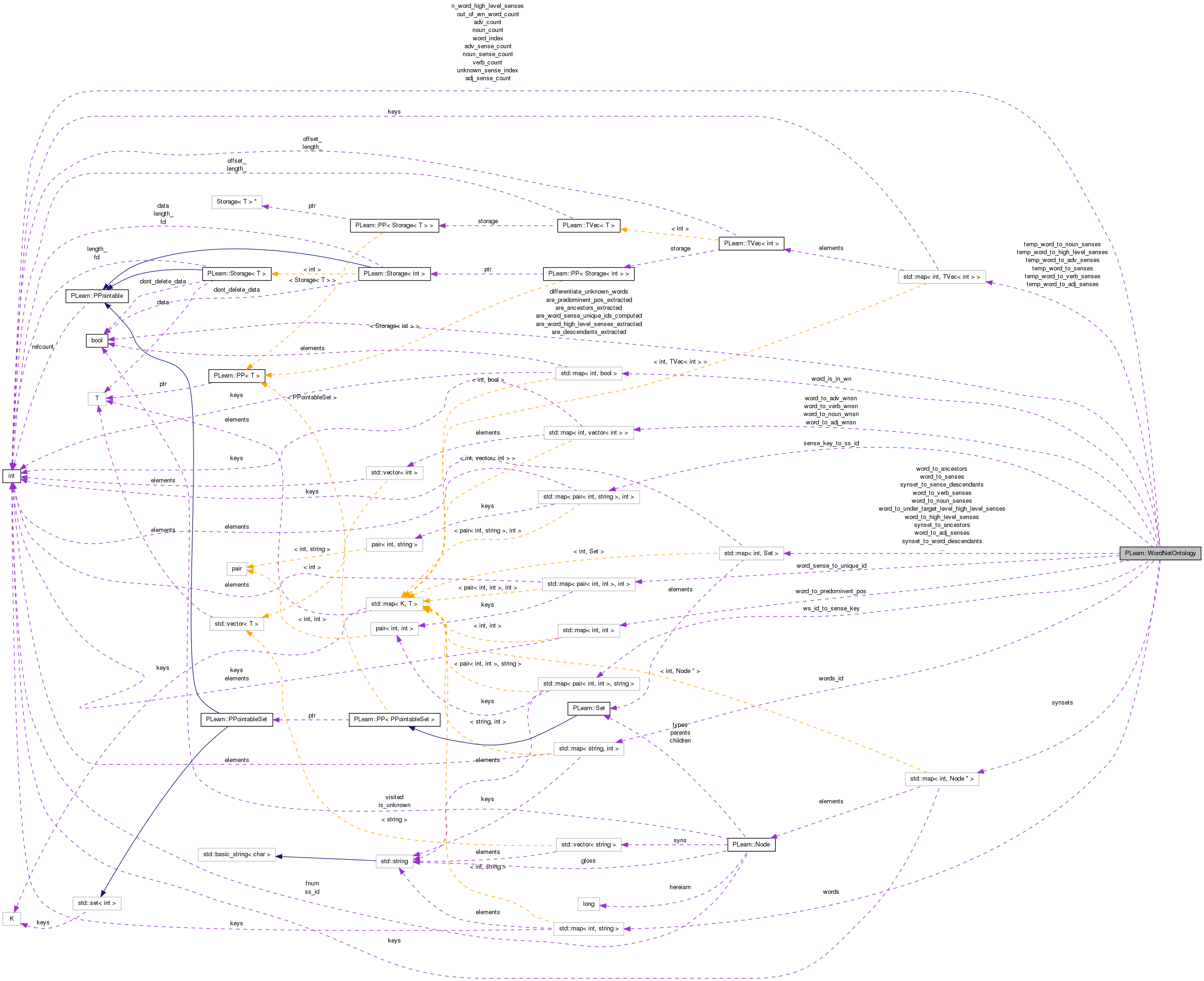
Definition at line 162 of file WordNetOntology.h.
| PLearn::WordNetOntology::WordNetOntology | ( | ) |
Definition at line 51 of file WordNetOntology.cc.
{
init();
createBaseSynsets();
}
| PLearn::WordNetOntology::WordNetOntology | ( | string | voc_file, |
| bool | differentiate_unknown_words, | ||
| bool | pre_compute_ancestors, | ||
| bool | pre_compute_descendants, | ||
| int | wn_pos_type = ALL_WN_TYPE, |
||
| int | word_coverage_threshold = -1 |
||
| ) |
Definition at line 57 of file WordNetOntology.cc.
References PLearn::extract(), and PLearn::extractAncestors().
{
init(differentiate_unknown_words);
createBaseSynsets();
extract(voc_file, wn_pos_type);
if (pre_compute_descendants)
extractDescendants();
if (pre_compute_ancestors)
extractAncestors(word_coverage_threshold, true, true);
}

| PLearn::WordNetOntology::WordNetOntology | ( | string | voc_file, |
| string | synset_file, | ||
| string | ontology_file, | ||
| bool | pre_compute_ancestors, | ||
| bool | pre_compute_descendants, | ||
| int | word_coverage_threshold = -1 |
||
| ) |
Definition at line 73 of file WordNetOntology.cc.
References PLearn::extractAncestors(), and PLearn::load().
{
init();
//createBaseSynsets();
load(voc_file, synset_file, ontology_file);
if (pre_compute_descendants)
extractDescendants();
if (pre_compute_ancestors)
extractAncestors(word_coverage_threshold, true, true);
}
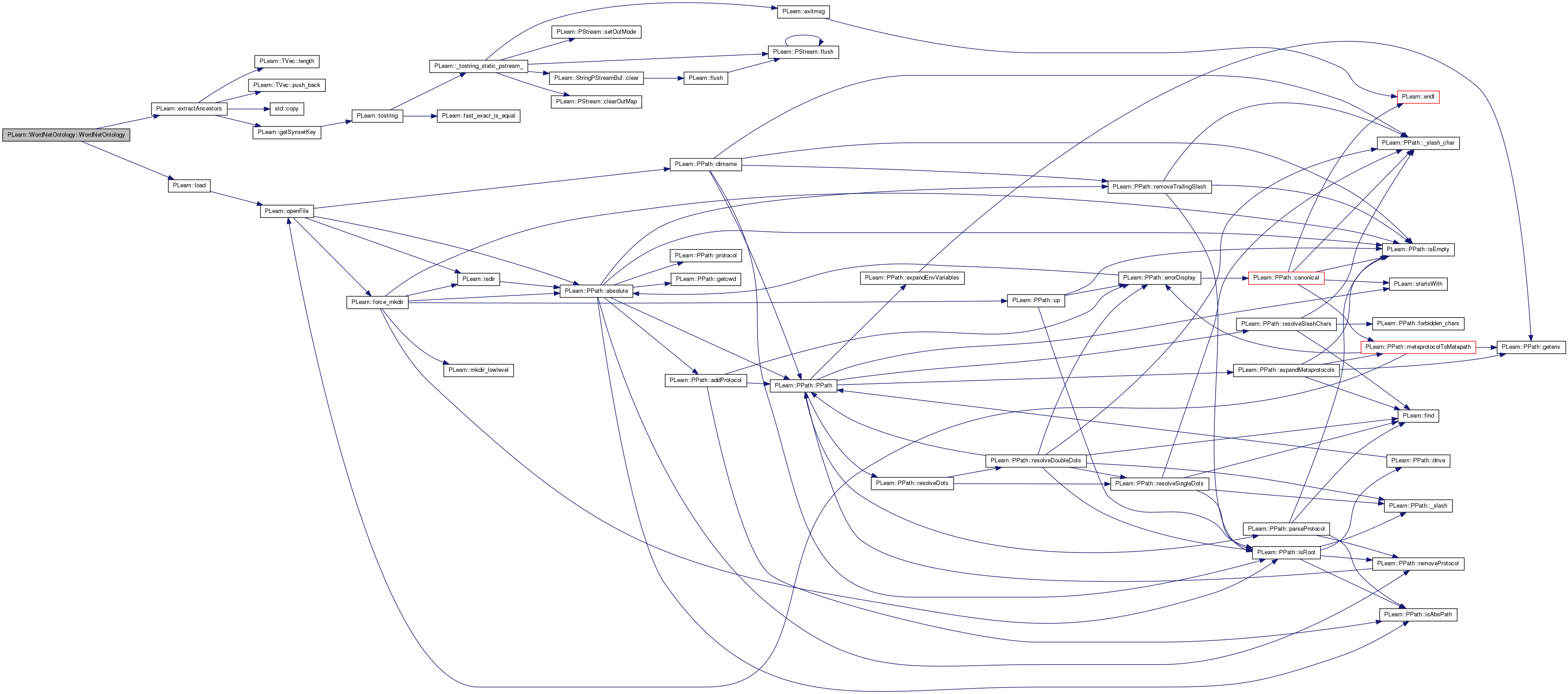
| PLearn::WordNetOntology::WordNetOntology | ( | string | voc_file, |
| string | synset_file, | ||
| string | ontology_file, | ||
| string | sense_key_file, | ||
| bool | pre_compute_ancestors, | ||
| bool | pre_compute_descendants, | ||
| int | word_coverage_threshold = -1 |
||
| ) |
Definition at line 89 of file WordNetOntology.cc.
References PLearn::extractAncestors(), and PLearn::load().
{
init();
//createBaseSynsets();
load(voc_file, synset_file, ontology_file, sense_key_file);
if (pre_compute_descendants)
extractDescendants();
if (pre_compute_ancestors)
extractAncestors(word_coverage_threshold, true, true);
}
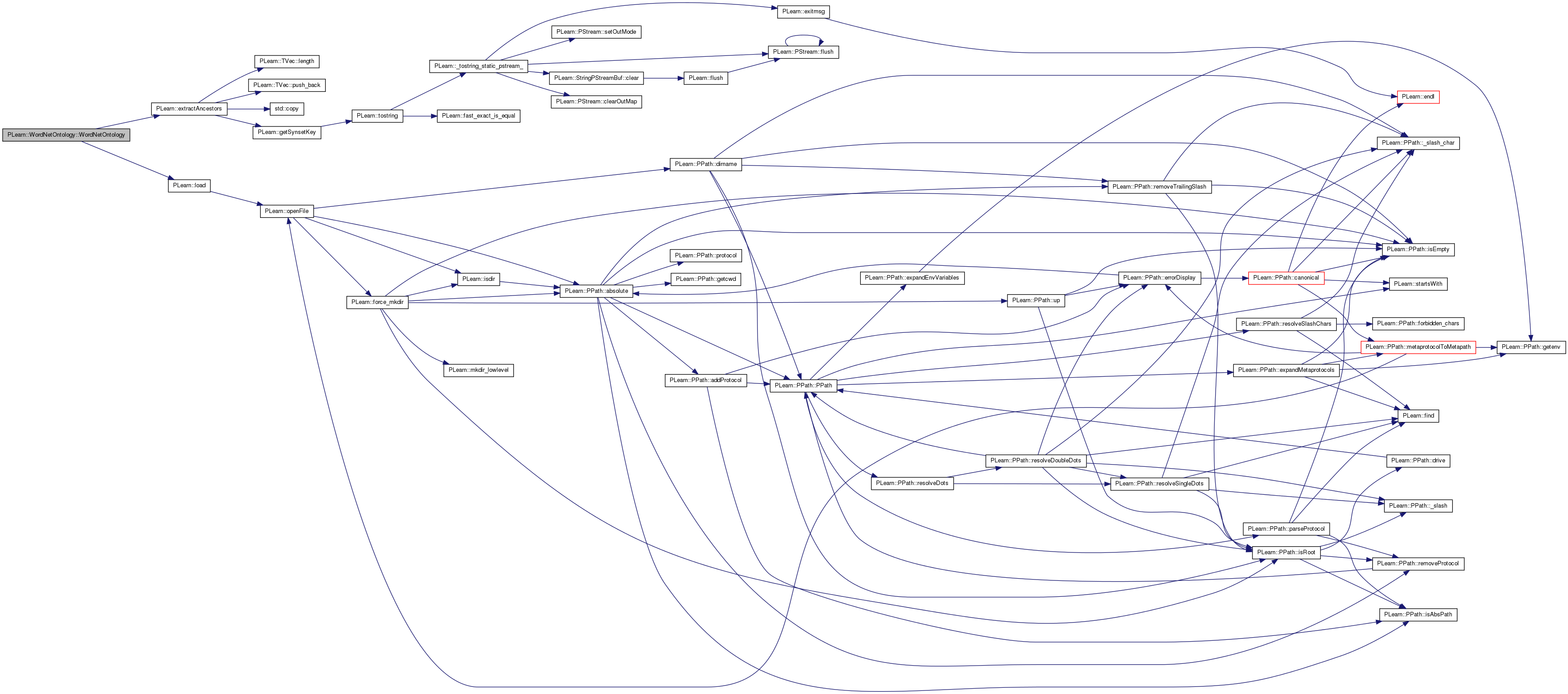
Definition at line 334 of file WordNetOntology.h.
References overlappingSynsets().
{ return (overlappingSynsets(ss_id1, ss_id2) > 1); }

| bool PLearn::WordNetOntology::catchSpecialTags | ( | string | word | ) |
Definition at line 763 of file WordNetOntology.cc.
References BOS_SS_ID, BOS_TAG, EOS_SS_ID, EOS_TAG, NUMERIC_SS_ID, NUMERIC_TAG, OOV_SS_ID, OOV_TAG, PROPER_NOUN_SS_ID, PROPER_NOUN_TAG, PUNCTUATION_SS_ID, PUNCTUATION_TAG, STOP_SS_ID, and STOP_TAG.
{
int word_id = words_id[word];
if (word == OOV_TAG)
{
word_to_senses[word_id].insert(OOV_SS_ID);
sense_to_words[OOV_SS_ID].insert(word_id);
return true;
} else if (word == PROPER_NOUN_TAG)
{
word_to_senses[word_id].insert(PROPER_NOUN_SS_ID);
sense_to_words[PROPER_NOUN_SS_ID].insert(word_id);
return true;
} else if (word == NUMERIC_TAG)
{
word_to_senses[word_id].insert(NUMERIC_SS_ID);
sense_to_words[NUMERIC_SS_ID].insert(word_id);
return true;
} else if (word == PUNCTUATION_TAG)
{
word_to_senses[word_id].insert(PUNCTUATION_SS_ID);
sense_to_words[PUNCTUATION_SS_ID].insert(word_id);
return true;
} else if (word == STOP_TAG)
{
word_to_senses[word_id].insert(STOP_SS_ID);
sense_to_words[STOP_SS_ID].insert(word_id);
return true;
} else if (word == BOS_TAG)
{
word_to_senses[word_id].insert(BOS_SS_ID);
sense_to_words[BOS_SS_ID].insert(word_id);
return true;
} else if (word == EOS_TAG)
{
word_to_senses[word_id].insert(EOS_SS_ID);
sense_to_words[EOS_SS_ID].insert(word_id);
return true;
}
return false;
}
| Node * PLearn::WordNetOntology::checkForAlreadyExtractedSynset | ( | SynsetPtr | ssp | ) |
Definition at line 1038 of file WordNetOntology.cc.
References PLearn::Node::fnum, PLearn::Node::gloss, PLearn::Node::hereiam, and PLearn::Node::syns.
{
vector<string> syns = getSynsetWords(ssp);
string gloss = ssp->defn;
long offset = ssp->hereiam;
int fnum = ssp->fnum;
for (map<int, Node*>::iterator it = synsets.begin(); it != synsets.end(); ++it)
{
Node* node = it->second;
if (node->syns == syns && node->gloss == gloss && node->hereiam == offset && node->fnum == fnum)
{
return node;
}
}
return NULL;
}
| void PLearn::WordNetOntology::computeWordSenseUniqueIds | ( | ) |
Definition at line 2788 of file WordNetOntology.cc.
References PLearn::Set::begin(), PLearn::Set::end(), PLERROR, w, and PLearn::ws().
{
int unique_id = 0;
for (map<int, Set>::iterator wit = word_to_senses.begin(); wit != word_to_senses.end(); ++wit)
{
int w = wit->first;
Set senses = wit->second;
for (SetIterator sit = senses.begin(); sit != senses.end(); ++sit)
{
int s = *sit;
pair<int, int> ws(w, s);
if (word_sense_to_unique_id.find(ws) != word_sense_to_unique_id.end())
PLERROR("in computeWordSenseUniqueIds(): dupe word/sense keys (w = %d, s = %d)", w, s);
word_sense_to_unique_id[ws] = unique_id++;
}
}
are_word_sense_unique_ids_computed = true;
}

| bool PLearn::WordNetOntology::containsWord | ( | string | word | ) | [inline] |
Definition at line 315 of file WordNetOntology.h.
References words.
| void PLearn::WordNetOntology::createBaseSynsets | ( | ) |
Definition at line 140 of file WordNetOntology.cc.
References ADJ_OFFSET, ADJ_SS_ID, ADV_OFFSET, ADV_SS_ID, BOS_OFFSET, BOS_SS_ID, PLearn::Node::children, EOS_OFFSET, EOS_SS_ID, PLearn::Node::gloss, PLearn::Node::hereiam, PLearn::Set::insert(), NOUN_OFFSET, NOUN_SS_ID, NUMERIC_OFFSET, NUMERIC_SS_ID, OOV_OFFSET, OOV_SS_ID, PLearn::Node::parents, PROPER_NOUN_OFFSET, PROPER_NOUN_SS_ID, PUNCTUATION_OFFSET, PUNCTUATION_SS_ID, ROOT_OFFSET, ROOT_SS_ID, STOP_OFFSET, STOP_SS_ID, SUPER_UNKNOWN_OFFSET, SUPER_UNKNOWN_SS_ID, PLearn::Node::syns, PLearn::Node::types, UNDEFINED_TYPE, VERB_OFFSET, and VERB_SS_ID.
{
// create ROOT synset
Node* root_node = new Node(ROOT_SS_ID);
root_node->syns.push_back("ROOT");
root_node->types.insert(UNDEFINED_TYPE);
root_node->gloss = "(root concept)";
root_node->hereiam = ROOT_OFFSET;
synsets[ROOT_SS_ID] = root_node;
//root_node->visited = true;
// create SUPER-UNKNOWN synset
Node* unk_node = new Node(SUPER_UNKNOWN_SS_ID);
unk_node->syns.push_back("SUPER_UNKNOWN");
unk_node->types.insert(UNDEFINED_TYPE);
unk_node->gloss = "(super-unknown concept)";
unk_node->hereiam = SUPER_UNKNOWN_OFFSET;
synsets[SUPER_UNKNOWN_SS_ID] = unk_node;
//unk_node->visited = true;
// link it <-> ROOT
unk_node->parents.insert(ROOT_SS_ID);
root_node->children.insert(SUPER_UNKNOWN_SS_ID);
// create OOV (out-of-vocabulary) synset
Node* oov_node = new Node(OOV_SS_ID);
oov_node->syns.push_back("OOV");
oov_node->types.insert(UNDEFINED_TYPE);
oov_node->gloss = "(out-of-vocabulary)";
oov_node->hereiam = OOV_OFFSET;
synsets[OOV_SS_ID] = oov_node;
//oov_node->visited = true;
// link it <-> SUPER-UNKNOWN
oov_node->parents.insert(SUPER_UNKNOWN_SS_ID);
unk_node->children.insert(OOV_SS_ID);
// create PROPER_NOUN, NUMERIC, PUNCTUATION, BOS, EOS and STOP synsets
Node* proper_node = new Node(PROPER_NOUN_SS_ID);
proper_node->syns.push_back("PROPER NOUN");
proper_node->types.insert(UNDEFINED_TYPE);
proper_node->gloss = "(proper noun)";
proper_node->hereiam = PROPER_NOUN_OFFSET;
synsets[PROPER_NOUN_SS_ID] = proper_node;
//proper_node->visited = true;
Node* num_node = new Node(NUMERIC_SS_ID);
num_node->syns.push_back("NUMERIC");
num_node->types.insert(UNDEFINED_TYPE);
num_node->gloss = "(numeric)";
num_node->hereiam = NUMERIC_OFFSET;
synsets[NUMERIC_SS_ID] = num_node;
//num_node->visited = true;
Node* punct_node = new Node(PUNCTUATION_SS_ID);
punct_node->syns.push_back("PUNCTUATION");
punct_node->types.insert(UNDEFINED_TYPE);
punct_node->gloss = "(punctuation)";
punct_node->hereiam = PUNCTUATION_OFFSET;
synsets[PUNCTUATION_SS_ID] = punct_node;
//punct_node->visited = true;
Node* stop_node = new Node(STOP_SS_ID);
stop_node->syns.push_back("STOP");
stop_node->types.insert(UNDEFINED_TYPE);
stop_node->gloss = "(stop)";
stop_node->hereiam = STOP_OFFSET;
synsets[STOP_SS_ID] = stop_node;
Node* bos_node = new Node(BOS_SS_ID);
bos_node->syns.push_back("BOS");
bos_node->types.insert(UNDEFINED_TYPE);
bos_node->gloss = "(BOS)";
bos_node->hereiam = BOS_OFFSET;
synsets[BOS_SS_ID] = bos_node;
Node* eos_node = new Node(EOS_SS_ID);
eos_node->syns.push_back("EOS");
eos_node->types.insert(UNDEFINED_TYPE);
eos_node->gloss = "(EOS)";
eos_node->hereiam = EOS_OFFSET;
synsets[EOS_SS_ID] = eos_node;
// link them <-> SUPER-UNKNOWN
proper_node->parents.insert(SUPER_UNKNOWN_SS_ID);
unk_node->children.insert(PROPER_NOUN_SS_ID);
num_node->parents.insert(SUPER_UNKNOWN_SS_ID);
unk_node->children.insert(NUMERIC_SS_ID);
punct_node->parents.insert(SUPER_UNKNOWN_SS_ID);
unk_node->children.insert(PUNCTUATION_SS_ID);
stop_node->parents.insert(SUPER_UNKNOWN_SS_ID);
unk_node->children.insert(STOP_SS_ID);
bos_node->parents.insert(SUPER_UNKNOWN_SS_ID);
unk_node->children.insert(BOS_SS_ID);
eos_node->parents.insert(SUPER_UNKNOWN_SS_ID);
unk_node->children.insert(EOS_SS_ID);
// create NOUN, VERB, ADJECTIVE and ADVERB synsets
Node* noun_node = new Node(NOUN_SS_ID);
noun_node->syns.push_back("NOUN");
noun_node->types.insert(UNDEFINED_TYPE);
noun_node->gloss = "(noun concept)";
noun_node->hereiam = NOUN_OFFSET;
synsets[NOUN_SS_ID] = noun_node;
//noun_node->visited = true;
Node* verb_node = new Node(VERB_SS_ID);
verb_node->syns.push_back("VERB");
verb_node->types.insert(UNDEFINED_TYPE);
verb_node->gloss = "(verb concept)";
verb_node->hereiam = VERB_OFFSET;
synsets[VERB_SS_ID] = verb_node;
//verb_node->visited = true;
Node* adj_node = new Node(ADJ_SS_ID);
adj_node->syns.push_back("ADJECTIVE");
adj_node->types.insert(UNDEFINED_TYPE);
adj_node->gloss = "(adjective concept)";
adj_node->hereiam = ADJ_OFFSET;
synsets[ADJ_SS_ID] = adj_node;
//adj_node->visited = true;
Node* adv_node = new Node(ADV_SS_ID);
adv_node->syns.push_back("ADVERB");
adv_node->types.insert(UNDEFINED_TYPE);
adv_node->gloss = "(adverb concept)";
adv_node->hereiam = ADV_OFFSET;
synsets[ADV_SS_ID] = adv_node;
//adv_node->visited = true;
// link them <-> ROOT
noun_node->parents.insert(ROOT_SS_ID);
root_node->children.insert(NOUN_SS_ID);
verb_node->parents.insert(ROOT_SS_ID);
root_node->children.insert(VERB_SS_ID);
adj_node->parents.insert(ROOT_SS_ID);
root_node->children.insert(ADJ_SS_ID);
adv_node->parents.insert(ROOT_SS_ID);
root_node->children.insert(ADV_SS_ID);
}

| void PLearn::WordNetOntology::detectWordsWithoutOntology | ( | ) |
Definition at line 2489 of file WordNetOntology.cc.
References PLearn::Set::isEmpty(), and PLWARNING.
Referenced by main().
{
for (map<int, Set>::iterator it = word_to_senses.begin(); it != word_to_senses.end(); ++it)
{
int word_id = it->first;
Set senses = it->second;
if (senses.isEmpty())
PLWARNING("word %d (%s) has no attached ontology", word_id, words[word_id].c_str());
}
}


| void PLearn::WordNetOntology::extract | ( | string | voc_file, |
| int | wn_pos_type | ||
| ) |
Definition at line 282 of file WordNetOntology.cc.
References PLearn::ShellProgressBar::done(), PLearn::ShellProgressBar::draw(), PLearn::ShellProgressBar::getAsciiFileLineCount(), and PLearn::ShellProgressBar::update().
{
int n_lines = ShellProgressBar::getAsciiFileLineCount(voc_file);
ShellProgressBar progress(0, n_lines - 1, "extracting ontology", 50);
progress.draw();
ifstream input_if(voc_file.c_str());
string word;
while (!input_if.eof())
{
getline(input_if, word, '\n');
if (word == "") continue;
if (word[0] == '#' && word[1] == '#') continue;
extractWord(word, wn_pos_type, true, true, false);
progress.update(word_index);
}
input_if.close();
progress.done();
finalize();
input_if.close();
}

| void PLearn::WordNetOntology::extractAncestors | ( | Node * | node, |
| Set | ancestors, | ||
| int | level, | ||
| int | level_threshold | ||
| ) |
Definition at line 1517 of file WordNetOntology.cc.
References PLearn::Set::begin(), PLearn::Set::end(), PLearn::extractAncestors(), PLearn::Set::insert(), and PLearn::Node::parents.
{
for (SetIterator it = node->parents.begin(); it != node->parents.end(); ++it)
{
ancestors.insert(*it);
if (level_threshold == -1 || level < level_threshold)
extractAncestors(synsets[*it], ancestors, level + 1, level_threshold);
}
}

| void PLearn::WordNetOntology::extractAncestors | ( | Node * | node, |
| Set | ancestors, | ||
| int | word_coverage_threshold | ||
| ) |
Definition at line 1491 of file WordNetOntology.cc.
References PLearn::Set::begin(), PLearn::Set::end(), PLearn::extractAncestors(), PLearn::Set::insert(), and PLearn::Node::parents.
{
/*
int ss_id = node->ss_id;
if (word_coverage_threshold == -1 || synset_to_word_descendants[ss_id].size() < word_coverage_threshold)
{
ancestors.insert(ss_id);
for (SetIterator it = node->parents.begin(); it != node->parents.end(); ++it)
{
extractAncestors(synsets[*it], ancestors, word_coverage_threshold);
}
}
*/
for (SetIterator it = node->parents.begin(); it != node->parents.end(); ++it)
{
int ss_id = *it;
if (word_coverage_threshold == -1 || synset_to_word_descendants[ss_id].size() < word_coverage_threshold)
{
ancestors.insert(ss_id);
extractAncestors(synsets[ss_id], ancestors, word_coverage_threshold);
}
}
}

| void PLearn::WordNetOntology::extractAncestors | ( | int | threshold, |
| bool | cut_with_word_coverage, | ||
| bool | exclude_itself | ||
| ) |
Definition at line 1435 of file WordNetOntology.cc.
References PLearn::Set::begin(), PLearn::Set::end(), PLearn::endl(), PLearn::extractAncestors(), PLearn::Set::insert(), PLearn::Set::merge(), and PLearn::Set::size().
Referenced by PLearn::GraphicalBiText::compute_nodemap().
{
#ifdef VERBOSE
cout << "extracting ancestors... ";
#endif
if (cut_with_word_coverage && !are_descendants_extracted)
{
cout << "*** I need to extract descendants before I can extract ancestors with a word coverage threshold ***" << endl;
extractDescendants();
}
// synsets -> ancestors
int n_sense_ancestors = 0;
for (map<int, Node*>::iterator it = synsets.begin(); it != synsets.end(); ++it)
{
int ss = it->first;
Node* node = it->second;
Set ancestors;
if (cut_with_word_coverage)
extractAncestors(node, ancestors, threshold);
else
extractAncestors(node, ancestors, 1, threshold);
if (!exclude_itself)
ancestors.insert(ss);
synset_to_ancestors[ss] = ancestors;
n_sense_ancestors += ancestors.size();
}
are_ancestors_extracted = true;
// words -> ancestors
int n_word_ancestors = 0;
for (map<int, Set>::iterator it = word_to_senses.begin(); it != word_to_senses.end(); ++it)
{
int word_id = it->first;
Set senses = it->second;
Set word_ancestors;
for (SetIterator it = senses.begin(); it != senses.end(); it++)
{
int sense_id = *it;
Set ancestors = getSynsetAncestors(sense_id);
word_ancestors.merge(ancestors);
word_ancestors.insert(sense_id);
}
word_to_ancestors[word_id] = word_ancestors;
n_word_ancestors += word_ancestors.size();
}
#ifdef VERBOSE
cout << "(" << n_sense_ancestors << " sense ancestors, " << n_word_ancestors << " word ancestors)" << endl;
#endif
}


| void PLearn::WordNetOntology::extractDescendants | ( | Node * | node, |
| Set | sense_descendants, | ||
| Set | word_descendants | ||
| ) |
Definition at line 1859 of file WordNetOntology.cc.
References PLearn::Set::begin(), PLearn::Node::children, PLearn::Set::end(), PLearn::Set::insert(), and PLearn::Node::ss_id.
{
int ss_id = node->ss_id;
if (isSense(ss_id)) // is a sense
{
sense_descendants.insert(ss_id);
for (SetIterator it = sense_to_words[ss_id].begin(); it != sense_to_words[ss_id].end(); ++it)
{
int word_id = *it;
word_descendants.insert(word_id);
}
}
for (SetIterator it = node->children.begin(); it != node->children.end(); ++it)
{
extractDescendants(synsets[*it], sense_descendants, word_descendants);
}
}

| void PLearn::WordNetOntology::extractDescendants | ( | ) |
Definition at line 1833 of file WordNetOntology.cc.
References PLearn::endl(), and PLearn::Set::size().
{
#ifdef VERBOSE
cout << "extracting descendants... ";
#endif
int n_sense_descendants = 0;
int n_word_descendants = 0;
for (map<int, Node*>::iterator it = synsets.begin(); it != synsets.end(); ++it)
{
Set sense_descendants;
Set word_descendants;
extractDescendants(it->second, sense_descendants, word_descendants);
synset_to_sense_descendants[it->first] = sense_descendants;
synset_to_word_descendants[it->first] = word_descendants;
n_sense_descendants += sense_descendants.size();
n_word_descendants += word_descendants.size();
}
are_descendants_extracted = true;
#ifdef VERBOSE
cout << "(" << n_sense_descendants << " senses, " << n_word_descendants << " words)" << endl;
#endif
}

| Node * PLearn::WordNetOntology::extractOntology | ( | SynsetPtr | ssp | ) |
Definition at line 729 of file WordNetOntology.cc.
References PLearn::Node::children, PLearn::Set::contains(), PLearn::Node::fnum, PLearn::Node::gloss, PLearn::Node::hereiam, PLearn::Set::insert(), PLearn::Node::is_unknown, PLearn::Node::parents, PLearn::removeDelimiters(), PLearn::Node::ss_id, and PLearn::Node::syns.
{
Node* node = new Node(synset_index++); // increment synset counter
node->syns = getSynsetWords(ssp);
string defn = ssp->defn;
removeDelimiters(defn, "*", "%");
removeDelimiters(defn, "|", "/");
node->gloss = defn;
node->hereiam = ssp->hereiam;
node->fnum = ssp->fnum;
node->is_unknown = false;
synsets[node->ss_id] = node;
ssp = ssp->ptrlist;
while (ssp != NULL)
{
Node* parent_node = checkForAlreadyExtractedSynset(ssp);
if (parent_node == NULL) // create new synset Node
{
parent_node = extractOntology(ssp);
}
if (parent_node->ss_id != node->ss_id && !(node->children.contains(parent_node->ss_id))) // avoid cycles (that are in fact due to errors in the WordNet database)
{
node->parents.insert(parent_node->ss_id);
parent_node->children.insert(node->ss_id);
}
ssp = ssp->nextss;
}
return node;
}

| void PLearn::WordNetOntology::extractPredominentSyntacticClasses | ( | ) |
Definition at line 2579 of file WordNetOntology.cc.
{
for (map<int, Set>::iterator it = word_to_senses.begin(); it != word_to_senses.end(); ++it)
{
int word_id = it->first;
word_to_predominent_pos[word_id] = getPredominentSyntacticClassForWord(word_id);
}
are_predominent_pos_extracted = true;
}
| bool PLearn::WordNetOntology::extractSenses | ( | string | original_word, |
| string | processed_word, | ||
| int | wn_pos_type | ||
| ) |
Definition at line 604 of file WordNetOntology.cc.
References ADJ_TYPE, ADV_TYPE, PLearn::cstr(), PLearn::Set::insert(), NOUN_TYPE, PLearn::Node::ss_id, PLearn::Node::types, VERB_TYPE, and PLearn::ws().
{
//char* cword = const_cast<char*>(processed_word.c_str());
char* cword = cstr(processed_word);
SynsetPtr ssp = NULL;
IndexPtr idx = getindex(cword, wn_pos_type);
switch (wn_pos_type)
{
case NOUN_TYPE:
ssp = findtheinfo_ds(cword, NOUN, -HYPERPTR, ALLSENSES);
break;
case VERB_TYPE:
ssp = findtheinfo_ds(cword, VERB, -HYPERPTR, ALLSENSES);
break;
case ADJ_TYPE:
ssp = findtheinfo_ds(cword, ADJ, -HYPERPTR, ALLSENSES);
break;
case ADV_TYPE:
ssp = findtheinfo_ds(cword, ADV, -HYPERPTR, ALLSENSES);
break;
}
if (ssp == NULL)
{
return false;
} else
{
switch (wn_pos_type)
{
case NOUN_TYPE:
noun_count++;
break;
case VERB_TYPE:
verb_count++;
break;
case ADJ_TYPE:
adj_count++;
break;
case ADV_TYPE:
adv_count++;
break;
}
int wnsn = 0;
// extract all senses for a given word
while (ssp != NULL)
{
wnsn++;
Node* node = checkForAlreadyExtractedSynset(ssp);
if (node == NULL) // not found
{
switch (wn_pos_type)
{
case NOUN_TYPE:
noun_sense_count++;
break;
case VERB_TYPE:
verb_sense_count++;
break;
case ADJ_TYPE:
adj_sense_count++;
break;
case ADV_TYPE:
adv_sense_count++;
break;
}
// create a new sense (1rst-level synset Node)
node = extractOntology(ssp);
}
int word_id = words_id[original_word];
node->types.insert(wn_pos_type);
word_to_senses[word_id].insert(node->ss_id);
sense_to_words[node->ss_id].insert(word_id);
char *charsk = WNSnsToStr(idx, wnsn);
string sense_key(charsk);
pair<int, string> ss(word_id,sense_key);
if (sense_key_to_ss_id.find(ss) == sense_key_to_ss_id.end())
sense_key_to_ss_id[ss] = node->ss_id;
pair<int, int> ws(word_id, node->ss_id);
//cout << sense_key << "word_id: " << word_id << "synset " << node->ss_id << endl;
// e.g. green%1:13:00:: and greens%1:13:00::
// correspond to the same synset
if (ws_id_to_sense_key.find(ws) == ws_id_to_sense_key.end())
ws_id_to_sense_key[ws] = sense_key;
// warning : should check if inserting a given sense twice (vector)
// (should not happen if vocabulary contains only unique values)
switch(wn_pos_type)
{
case NOUN_TYPE:
word_to_noun_wnsn[word_id].push_back(node->ss_id);
word_to_noun_senses[word_id].insert(node->ss_id);
break;
case VERB_TYPE:
word_to_verb_wnsn[word_id].push_back(node->ss_id);
word_to_verb_senses[word_id].insert(node->ss_id);
break;
case ADJ_TYPE:
word_to_adj_wnsn[word_id].push_back(node->ss_id);
word_to_adj_senses[word_id].insert(node->ss_id);
break;
case ADV_TYPE:
word_to_adv_wnsn[word_id].push_back(node->ss_id);
word_to_adv_senses[word_id].insert(node->ss_id);
break;
}
ssp = ssp->nextss;
}
free_syns(ssp);
return true;
}
}

| void PLearn::WordNetOntology::extractStrictDescendants | ( | Node * | node, |
| Set | sense_descendants, | ||
| Set | word_descendants | ||
| ) |
Definition at line 1878 of file WordNetOntology.cc.
References PLearn::Set::begin(), PLearn::Node::children, PLearn::Set::end(), PLearn::Set::insert(), and PLearn::Node::ss_id.
{
int ss_id = node->ss_id;
if (isSense(ss_id)){ // is a sense
for (SetIterator it = sense_to_words[ss_id].begin(); it != sense_to_words[ss_id].end(); ++it){
int word_id = *it;
word_descendants.insert(word_id);
}
}
for (SetIterator it = node->children.begin(); it != node->children.end(); ++it){
extractDescendants(synsets[*it], sense_descendants, word_descendants);
}
}

| void PLearn::WordNetOntology::extractTaggedWordFrequencies | ( | map< int, map< int, int > > & | word_senses_to_tagged_frequencies | ) |
Definition at line 489 of file WordNetOntology.cc.
References PLearn::cstr(), PLearn::ShellProgressBar::draw(), PLearn::endl(), i, and PLearn::Node::ss_id.
{
// NOTE: The 'word_senses_to_tagged_frequencies' is a map where the key to the
// map is a 'word_id' and the value associated with the key is another
// map. This other map takes a 'synset_id' as its key and associates
// a frequency value. Thus the data structure associates a frequency
// to a (word_id, synset_id) couple.
cout << "in WordNetOntology::extractTaggedWordFrequencies()" << endl;
vector<int> dbases;
dbases.reserve(4);
dbases.push_back(NOUN);
dbases.push_back(VERB);
dbases.push_back(ADJ);
dbases.push_back(ADV);
int dbases_size = dbases.size();
word_senses_to_tagged_frequencies.clear();
vector<string> syns;
string gloss;
long offset;
int fnum;
int total_senses_found = 0;
ShellProgressBar progress(0, words.size() * dbases_size, "[Extracting word-sense tagged frequencies]", 50);
progress.draw();
int ws2tf_i = 0;
// Go through all databases
for (int i = 0; i < dbases_size; ++i) {
// Go through all words in the ontology
for (map<int, string>::iterator w_it = words.begin(); w_it != words.end(); ++w_it) {
progress.update(++ws2tf_i);
char *cword = cstr(w_it->second);
wnresults.numforms = wnresults.printcnt = 0; // Useful??
SynsetPtr ssp = findtheinfo_ds(cword, dbases[i], -HYPERPTR, ALLSENSES);
if (ssp != NULL) {
IndexPtr idx;
SynsetPtr cursyn;
while ((idx = getindex(cword, dbases[i])) != NULL) {
cword = NULL;
if (idx->tagged_cnt) {
map<int, map<int, int> >::iterator ws2tf_it = word_senses_to_tagged_frequencies.find(w_it->first);
if (ws2tf_it == word_senses_to_tagged_frequencies.end()) {
word_senses_to_tagged_frequencies[w_it->first] = map<int, int>();
ws2tf_it = word_senses_to_tagged_frequencies.find(w_it->first);
}
//for (int l = 0; l < idx->tagged_cnt; ++l) {
for (int l = 0; l < idx->sense_cnt; ++l) {
if ((cursyn = read_synset(dbases[i], idx->offset[l], idx->wd)) != NULL) {
//int freq = GetTagcnt(idx, l + 1);
int freq = -1;
wnresults.OutSenseCount[wnresults.numforms]++;
// Find if synset is in ontology
//if (freq) {
// NOTE: We extract zero frequencies even though
// this is not useful...
syns = getSynsetWords(cursyn);
gloss = string(cursyn->defn);
offset = cursyn->hereiam;
fnum = cursyn->fnum;
Node *node = findSynsetFromSynsAndGloss(syns, gloss, offset, fnum);
if (node != NULL) {
(ws2tf_it->second)[node->ss_id] = freq;
++total_senses_found;
}
//}
free_synset(cursyn);
}
}
}
wnresults.numforms++;
free_index(idx);
} // while()
free_syns(ssp);
} // ssp != NULL
}
}
progress.done();
cout << "FOUND A GRAND TOTAL OF " << total_senses_found << " senses" << endl;
}

| void PLearn::WordNetOntology::extractWord | ( | string | original_word, |
| int | wn_pos_type, | ||
| bool | trim_word, | ||
| bool | stem_word, | ||
| bool | remove_underscores | ||
| ) |
Definition at line 383 of file WordNetOntology.cc.
References ADJ_TYPE, ADV_TYPE, ALL_WN_TYPE, PLearn::extractSenses(), NOUN_TYPE, NULL_TAG, PLWARNING, PLearn::stemWord(), PLearn::trimWord(), PLearn::underscore_to_space(), and VERB_TYPE.
Referenced by main().
{
bool found_noun = false;
bool found_verb = false;
bool found_adj = false;
bool found_adv = false;
bool found_stemmed_noun = false;
bool found_stemmed_verb = false;
bool found_stemmed_adj = false;
bool found_stemmed_adv = false;
bool found = false;
string processed_word = original_word;
string stemmed_word;
words[word_index] = original_word;
words_id[original_word] = word_index;
if (!catchSpecialTags(original_word))
{
if (trim_word)
processed_word = trimWord(original_word);
if (remove_undescores)
processed_word = underscore_to_space(processed_word);
if (processed_word == NULL_TAG)
{
out_of_wn_word_count++;
processUnknownWord(word_index);
word_is_in_wn[word_index] = false;
} else
{
if (wn_pos_type == NOUN_TYPE || wn_pos_type == ALL_WN_TYPE)
found_noun = extractSenses(original_word, processed_word, NOUN_TYPE);
if (wn_pos_type == VERB_TYPE || wn_pos_type == ALL_WN_TYPE)
found_verb = extractSenses(original_word, processed_word, VERB_TYPE);
if (wn_pos_type == ADJ_TYPE || wn_pos_type == ALL_WN_TYPE)
found_adj = extractSenses(original_word, processed_word, ADJ_TYPE);
if (wn_pos_type == ADV_TYPE || wn_pos_type == ALL_WN_TYPE)
found_adv = extractSenses(original_word, processed_word, ADV_TYPE);
if (stem_word)
{
if (wn_pos_type == NOUN_TYPE || wn_pos_type == ALL_WN_TYPE)
{
stemmed_word = stemWord(processed_word, NOUN);
if (stemmed_word != processed_word)
found_stemmed_noun = extractSenses(original_word, stemmed_word, NOUN_TYPE);
}
if (wn_pos_type == VERB_TYPE || wn_pos_type == ALL_WN_TYPE)
{
stemmed_word = stemWord(processed_word, VERB);
if (stemmed_word != processed_word)
found_stemmed_verb = extractSenses(original_word, stemmed_word, VERB_TYPE);
}
if (wn_pos_type == ADJ_TYPE || wn_pos_type == ALL_WN_TYPE)
{
stemmed_word = stemWord(processed_word, ADJ);
if (stemmed_word != processed_word)
found_stemmed_adj = extractSenses(original_word, stemmed_word, ADJ_TYPE);
}
if (wn_pos_type == ADV_TYPE || wn_pos_type == ALL_WN_TYPE)
{
stemmed_word = stemWord(processed_word, ADV);
if (stemmed_word != processed_word)
found_stemmed_adv = extractSenses(original_word, stemmed_word, ADV_TYPE);
}
}
found = (found_noun || found_verb || found_adj || found_adv ||
found_stemmed_noun || found_stemmed_verb || found_stemmed_adj || found_stemmed_adv);
if (found)
{
in_wn_word_count++;
word_is_in_wn[word_index] = true;
} else
{
out_of_wn_word_count++;
processUnknownWord(word_index);
word_is_in_wn[word_index] = false;
}
}
} else // word is a "special tag" (<OOV>, etc...)
{
out_of_wn_word_count++;
word_is_in_wn[word_index] = false;
}
if (word_to_senses[word_index].isEmpty())
PLWARNING("word %d (%s) was not processed correctly (found = %d)", word_index, words[word_index].c_str(), found);
word_index++;
}


| void PLearn::WordNetOntology::extractWordHighLevelSenses | ( | int | noun_depth, |
| int | verb_depth, | ||
| int | adj_depth, | ||
| int | adv_depth, | ||
| int | unk_depth | ||
| ) |
Definition at line 2652 of file WordNetOntology.cc.
References ADJ_SS_ID, ADV_SS_ID, PLearn::Set::begin(), PLearn::Set::end(), NOUN_SS_ID, SUPER_UNKNOWN_SS_ID, and VERB_SS_ID.
{
Set noun_categories;
getDescendantCategoriesAtLevel(NOUN_SS_ID, 0, noun_depth, noun_categories);
for (SetIterator sit = noun_categories.begin(); sit != noun_categories.end(); ++sit)
{
int ss_id = *sit;
Set word_descendants = getSynsetWordDescendants(ss_id);
for (SetIterator wit = word_descendants.begin(); wit != word_descendants.end(); ++wit)
{
int word_id = *wit;
word_to_high_level_senses[word_id].insert(ss_id);
}
}
Set verb_categories;
getDescendantCategoriesAtLevel(VERB_SS_ID, 0, verb_depth, verb_categories);
for (SetIterator sit = verb_categories.begin(); sit != verb_categories.end(); ++sit)
{
int ss_id = *sit;
Set word_descendants = getSynsetWordDescendants(ss_id);
for (SetIterator wit = word_descendants.begin(); wit != word_descendants.end(); ++wit)
{
int word_id = *wit;
word_to_high_level_senses[word_id].insert(ss_id);
}
}
Set adj_categories;
getDescendantCategoriesAtLevel(ADJ_SS_ID, 0, adj_depth, adj_categories);
for (SetIterator sit = adj_categories.begin(); sit != adj_categories.end(); ++sit)
{
int ss_id = *sit;
Set word_descendants = getSynsetWordDescendants(ss_id);
for (SetIterator wit = word_descendants.begin(); wit != word_descendants.end(); ++wit)
{
int word_id = *wit;
word_to_high_level_senses[word_id].insert(ss_id);
}
}
Set adv_categories;
getDescendantCategoriesAtLevel(ADV_SS_ID, 0, adv_depth, adv_categories);
for (SetIterator sit = adv_categories.begin(); sit != adv_categories.end(); ++sit)
{
int ss_id = *sit;
Set word_descendants = getSynsetWordDescendants(ss_id);
for (SetIterator wit = word_descendants.begin(); wit != word_descendants.end(); ++wit)
{
int word_id = *wit;
word_to_high_level_senses[word_id].insert(ss_id);
}
}
Set unk_categories;
getDescendantCategoriesAtLevel(SUPER_UNKNOWN_SS_ID, 0, unk_depth, unk_categories);
for (SetIterator sit = unk_categories.begin(); sit != unk_categories.end(); ++sit)
{
int ss_id = *sit;
Set word_descendants = getSynsetWordDescendants(ss_id);
for (SetIterator wit = word_descendants.begin(); wit != word_descendants.end(); ++wit)
{
int word_id = *wit;
word_to_high_level_senses[word_id].insert(ss_id);
}
}
// This role is deprecated: integrity verification : to each word should be assigned at least 1 high-level sense
// The new role is now to assign "normal" senses to word that didn't get high-level senses
for (map<int, string>::iterator it = words.begin(); it != words.end(); ++it)
{
int word_id = it->first;
if (word_to_high_level_senses[word_id].size() == 0)
word_to_high_level_senses[word_id] = word_to_senses[word_id];
// This is deprecated: PLWARNING("word '%s' (%d) has no high-level sense", words[word_id].c_str(), word_id);
}
are_word_high_level_senses_extracted = true;
}

| void PLearn::WordNetOntology::extractWordNounAndVerbHighLevelSenses | ( | int | noun_depth, |
| int | verb_depth | ||
| ) |
Definition at line 2728 of file WordNetOntology.cc.
References PLearn::Set::begin(), PLearn::Set::end(), NOUN_SS_ID, and VERB_SS_ID.
{
for (map<int, string>::iterator it = words.begin(); it != words.end(); ++it)
{
int word_id = it->first;
word_to_high_level_senses[word_id] = word_to_adv_senses[word_id];
word_to_high_level_senses[word_id].merge(word_to_adj_senses[word_id]);
}
Set noun_categories;
getDescendantCategoriesAtLevel(NOUN_SS_ID, 0, noun_depth, noun_categories);
for (SetIterator sit = noun_categories.begin(); sit != noun_categories.end(); ++sit)
{
int ss_id = *sit;
Set word_descendants = getSynsetWordDescendants(ss_id);
for (SetIterator wit = word_descendants.begin(); wit != word_descendants.end(); ++wit)
{
int word_id = *wit;
word_to_high_level_senses[word_id].insert(ss_id);
}
}
Set verb_categories;
getDescendantCategoriesAtLevel(VERB_SS_ID, 0, verb_depth, verb_categories);
for (SetIterator sit = verb_categories.begin(); sit != verb_categories.end(); ++sit)
{
int ss_id = *sit;
Set word_descendants = getSynsetWordDescendants(ss_id);
for (SetIterator wit = word_descendants.begin(); wit != word_descendants.end(); ++wit)
{
int word_id = *wit;
word_to_high_level_senses[word_id].insert(ss_id);
}
}
// BIG HACK!!!
for (map<int, Set>::iterator it = word_to_under_target_level_high_level_senses.begin(); it != word_to_under_target_level_high_level_senses.end(); ++it)
{
word_to_high_level_senses[it->first].merge(it->second);
}
for (map<int, string>::iterator it = words.begin(); it != words.end(); ++it)
{
int word_id = it->first;
if (word_to_high_level_senses[word_id].size() == 0)
word_to_high_level_senses[word_id] = word_to_senses[word_id];
}
are_word_high_level_senses_extracted = true;
}

| void PLearn::WordNetOntology::fillTempWordToHighLevelSensesTVecMap | ( | ) | [inline] |
Definition at line 441 of file WordNetOntology.h.
References PLearn::Set::begin(), PLearn::Set::end(), getWordHighLevelSenses(), temp_word_to_high_level_senses, w, and words.
{
for (map<int, string>::iterator it = words.begin(); it != words.end(); ++it)
{
int w = it->first;
Set hl_senses = getWordHighLevelSenses(w);
for (SetIterator sit = hl_senses.begin(); sit != hl_senses.end(); ++sit)
temp_word_to_high_level_senses[w].push_back(*sit);
}
}

| void PLearn::WordNetOntology::fillTempWordToSensesTVecMap | ( | ) | [inline] |
Definition at line 396 of file WordNetOntology.h.
References PLearn::Set::begin(), PLearn::Set::end(), temp_word_to_adj_senses, temp_word_to_adv_senses, temp_word_to_noun_senses, temp_word_to_senses, temp_word_to_verb_senses, w, word_to_adj_senses, word_to_adv_senses, word_to_noun_senses, word_to_senses, and word_to_verb_senses.
Referenced by PLearn::GraphicalBiText::build_().
{
for (map<int, Set>::iterator it = word_to_senses.begin(); it != word_to_senses.end(); ++it)
{
int w = it->first;
Set senses = it->second;
for (SetIterator sit = senses.begin(); sit != senses.end(); ++sit)
temp_word_to_senses[w].push_back(*sit);
}
for (map<int, Set>::iterator it = word_to_noun_senses.begin(); it != word_to_noun_senses.end(); ++it)
{
int w = it->first;
Set senses = it->second;
for (SetIterator sit = senses.begin(); sit != senses.end(); ++sit)
temp_word_to_noun_senses[w].push_back(*sit);
}
for (map<int, Set>::iterator it = word_to_verb_senses.begin(); it != word_to_verb_senses.end(); ++it)
{
int w = it->first;
Set senses = it->second;
for (SetIterator sit = senses.begin(); sit != senses.end(); ++sit)
temp_word_to_verb_senses[w].push_back(*sit);
}
for (map<int, Set>::iterator it = word_to_adj_senses.begin(); it != word_to_adj_senses.end(); ++it)
{
int w = it->first;
Set senses = it->second;
for (SetIterator sit = senses.begin(); sit != senses.end(); ++sit)
temp_word_to_adj_senses[w].push_back(*sit);
}
for (map<int, Set>::iterator it = word_to_adv_senses.begin(); it != word_to_adv_senses.end(); ++it)
{
int w = it->first;
Set senses = it->second;
for (SetIterator sit = senses.begin(); sit != senses.end(); ++sit)
temp_word_to_adv_senses[w].push_back(*sit);
}
}


| void PLearn::WordNetOntology::finalize | ( | ) |
Definition at line 819 of file WordNetOntology.cc.
| Node * PLearn::WordNetOntology::findSynsetFromSynsAndGloss | ( | const vector< string > & | syns, |
| const string & | gloss, | ||
| const long | offset, | ||
| const int | fnum | ||
| ) |
Definition at line 478 of file WordNetOntology.cc.
References PLearn::Node::fnum, PLearn::Node::gloss, PLearn::Node::hereiam, and PLearn::Node::syns.
| Set PLearn::WordNetOntology::getAllCategories | ( | ) |
Definition at line 2035 of file WordNetOntology.cc.
References PLearn::Set::insert().
Referenced by PLearn::GraphicalBiText::check_set_pA(), PLearn::GraphicalBiText::compute_BN_likelihood(), PLearn::GraphicalBiText::compute_efs_likelihood(), PLearn::GraphicalBiText::compute_likelihood(), PLearn::GraphicalBiText::compute_pTC(), and PLearn::GraphicalBiText::print().
{
Set categories;
for (map<int, Node*>::iterator it = synsets.begin(); it != synsets.end(); ++it)
{
categories.insert(it->first);
}
return categories;
}


| Set PLearn::WordNetOntology::getAllSenses | ( | ) |
Definition at line 2025 of file WordNetOntology.cc.
References PLearn::Set::insert().
{
Set senses;
for (map<int, Set>::iterator it = sense_to_words.begin(); it != sense_to_words.end(); ++it)
{
senses.insert(it->first);
}
return senses;
}

| Set PLearn::WordNetOntology::getAllWords | ( | ) | const |
Definition at line 2016 of file WordNetOntology.cc.
References PLearn::Set::insert().
Referenced by PLearn::GraphicalBiText::build_(), PLearn::GraphicalBiText::compute_likelihood(), PLearn::GraphicalBiText::compute_nodemap(), PLearn::GraphicalBiText::computeKL(), PLearn::GraphicalBiText::init(), main(), PLearn::GraphicalBiText::print(), PLearn::GraphicalBiText::print_sensemap(), and PLearn::GraphicalBiText::test_WSD().
{
Set all_words;
for (map<int, string>::const_iterator it = words.begin(); it != words.end(); ++it){
all_words.insert(it->first);
}
return all_words;
}


| void PLearn::WordNetOntology::getCategoriesAtLevel | ( | int | ss_id, |
| int | cur_level, | ||
| int | target_level, | ||
| set< int > & | categories | ||
| ) |
Definition at line 2193 of file WordNetOntology.cc.
References PLearn::Set::begin(), PLearn::Set::end(), and PLearn::Node::parents.
{
Node* node = synsets[ss_id];
if (cur_level == target_level && !isTopLevelCategory(ss_id))
{
categories.insert(ss_id);
} else
{
for (SetIterator it = node->parents.begin(); it != node->parents.end(); ++it)
{
getCategoriesAtLevel(*it, cur_level + 1, target_level, categories);
}
}
}

| void PLearn::WordNetOntology::getCategoriesUnderLevel | ( | int | ss_id, |
| int | cur_level, | ||
| int | target_level, | ||
| Set | categories | ||
| ) |
Definition at line 2208 of file WordNetOntology.cc.
References PLearn::Set::begin(), PLearn::Set::end(), PLearn::Set::insert(), and PLearn::Node::parents.
{
Node* node = synsets[ss_id];
if (!isTopLevelCategory(ss_id))
categories.insert(ss_id);
if (cur_level != target_level)
{
for (SetIterator it = node->parents.begin(); it != node->parents.end(); ++it)
getCategoriesUnderLevel(*it, cur_level + 1, target_level, categories);
}
}

| void PLearn::WordNetOntology::getDescendantCategoriesAtLevel | ( | int | ss_id, |
| int | cur_level, | ||
| int | target_level, | ||
| Set | categories | ||
| ) |
Definition at line 2627 of file WordNetOntology.cc.
References PLearn::Set::begin(), PLearn::Node::children, PLearn::Set::end(), and PLearn::Set::insert().
{
if (isSynset(ss_id))
{
Node* node = synsets[ss_id];
// WARNING: HERE IS A HUGE HACK!!!
if (cur_level < target_level && isSense(ss_id))
{
Set words = sense_to_words[ss_id];
for (SetIterator wit = words.begin(); wit != words.end(); ++wit)
word_to_under_target_level_high_level_senses[*wit].insert(ss_id);
}
if (cur_level == target_level)
categories.insert(ss_id);
else
{
for (SetIterator it = node->children.begin(); it != node->children.end(); ++it)
getDescendantCategoriesAtLevel(*it, cur_level + 1, target_level, categories);
}
}
}

| void PLearn::WordNetOntology::getDownToUpParentCategoriesAtLevel | ( | int | ss_id, |
| int | target_level, | ||
| Set | categories, | ||
| int | cur_level = 0 |
||
| ) |
Definition at line 2180 of file WordNetOntology.cc.
References PLearn::Set::begin(), PLearn::Set::end(), PLearn::Set::insert(), and PLearn::Node::parents.
{
Node* node = synsets[ss_id];
if (cur_level == target_level && !isTopLevelCategory(ss_id))
{
categories.insert(ss_id);
} else
{
for (SetIterator it = node->parents.begin(); it != node->parents.end(); ++it)
getDownToUpParentCategoriesAtLevel(*it, target_level, categories, cur_level + 1);
}
}

Definition at line 451 of file WordNetOntology.h.
References temp_word_to_high_level_senses, and w.
{ return temp_word_to_high_level_senses[w]; }
| int PLearn::WordNetOntology::getMaxSynsetId | ( | ) |
Definition at line 2500 of file WordNetOntology.cc.
Referenced by PLearn::GraphicalBiText::build_().
{
return synsets.rbegin()->first;
}

Definition at line 2535 of file WordNetOntology.cc.
References ADJ_TYPE, ADV_TYPE, PLearn::Set::begin(), PLearn::Set::end(), NOUN_TYPE, PLWARNING, UNDEFINED_TYPE, and VERB_TYPE.
{
#ifndef NOWARNING
if (!isWord(word_id))
PLWARNING("asking for a non-word id (%d)", word_id);
#endif
if (are_predominent_pos_extracted)
return word_to_predominent_pos[word_id];
int n_noun = 0;
int n_verb = 0;
int n_adj = 0;
int n_adv = 0;
Set senses = word_to_senses[word_id];
for (SetIterator it = senses.begin(); it != senses.end(); ++it)
{
int sense_id = *it;
int type = getSyntacticClassForSense(sense_id);
switch (type)
{
case NOUN_TYPE:
n_noun++;
break;
case VERB_TYPE:
n_verb++;
break;
case ADJ_TYPE:
n_adj++;
break;
case ADV_TYPE:
n_adv++;
}
}
if (n_noun == 0 && n_verb == 0 && n_adj == 0 && n_adv == 0)
return UNDEFINED_TYPE;
else if (n_noun >= n_verb && n_noun >= n_adj && n_noun >= n_adv)
return NOUN_TYPE;
else if (n_verb >= n_noun && n_verb >= n_adj && n_verb >= n_adv)
return VERB_TYPE;
else if (n_adj >= n_noun && n_adj >= n_verb && n_adj >= n_adv)
return ADJ_TYPE;
else
return ADV_TYPE;
}

| Node* PLearn::WordNetOntology::getRootSynset | ( | ) | [inline] |
Definition at line 285 of file WordNetOntology.h.
References ROOT_SS_ID, and synsets.
{ return synsets[ROOT_SS_ID]; }
Definition at line 453 of file WordNetOntology.h.
References PLearn::Set::begin(), PLearn::Set::end(), PLearn::Set::insert(), PLearn::Node::parents, PLearn::TVec< T >::push_back(), synsets, w, and word_to_senses.
{
Set sl_senses;
Set senses = word_to_senses[w];
for (SetIterator sit = senses.begin(); sit != senses.end(); ++sit)
{
int s = *sit;
Node* node = synsets[s];
for (SetIterator ssit = node->parents.begin(); ssit != node->parents.end(); ++ssit)
{
sl_senses.insert(*ssit);
}
}
TVec<int> sl_senses_vec;
for (SetIterator slit = sl_senses.begin(); slit != sl_senses.end(); ++slit)
sl_senses_vec.push_back(*slit);
return sl_senses_vec;
}

Definition at line 1630 of file WordNetOntology.cc.
References PLWARNING, and PLearn::ws().
Referenced by PLearn::GraphicalBiText::compute_nodemap(), PLearn::GraphicalBiText::init(), PLearn::GraphicalBiText::init_WSD(), PLearn::GraphicalBiText::print(), PLearn::GraphicalBiText::senseTagBitext(), PLearn::GraphicalBiText::set_nodemap(), PLearn::GraphicalBiText::test_WSD(), and PLearn::GraphicalBiText::update_WSD_model().
{
pair<int, int> ws(word_id, ss_id);
if (ws_id_to_sense_key.find(ws) == ws_id_to_sense_key.end()){
PLWARNING("getSenseKey: can't find sense key word %d ss_id %d",word_id,ss_id);
return "";
}
return ws_id_to_sense_key.find(ws)->second;
}


Definition at line 439 of file WordNetOntology.h.
References temp_word_to_senses.
Referenced by PLearn::TextSenseSequenceVMatrix::permute(), PLearn::GraphicalBiText::print(), PLearn::GraphicalBiText::sensetag_valid_bitext(), PLearn::GraphicalBiText::senseTagBitext(), PLearn::GraphicalBiText::test_WSD(), and PLearn::GraphicalBiText::update_WSD_model().
{ return temp_word_to_senses.find(w)->second; }

| int PLearn::WordNetOntology::getSenseSize | ( | ) | [inline] |
Definition at line 290 of file WordNetOntology.h.
References sense_to_words.
Referenced by PLearn::GraphicalBiText::build_(), and PLearn::TextSenseSequenceVMatrix::build_().
{ return sense_to_words.size(); }

Definition at line 1781 of file WordNetOntology.cc.
References PLWARNING.
Referenced by PLearn::GraphicalBiText::check_set_pA(), PLearn::GraphicalBiText::compute_node_level(), PLearn::GraphicalBiText::compute_nodemap(), PLearn::GraphicalBiText::compute_pMC(), PLearn::GraphicalBiText::getDeepestCommonAncestor(), PLearn::GraphicalBiText::printNode(), and PLearn::GraphicalBiText::set_nodemap().
{
#ifndef NOWARNING
if (!isSynset(id))
{
PLWARNING("asking for a non-synset id (%d)", id);
return NULL;
}
#endif
#ifndef NOWARNING
if (synsets.find(id) == synsets.end()) {
PLWARNING("Asking for a non-existent synset id (%d)", id);
return NULL;
}
#endif
return synsets[id];
}

Definition at line 1558 of file WordNetOntology.cc.
References PLERROR, and PLWARNING.
{
if (are_ancestors_extracted)
{
if (!isSynset(id))
{
#ifndef NOWARNING
PLWARNING("asking for a non-synset id (%d)", id);
#endif
}
return synset_to_ancestors.find(id)->second;
} else
{
PLERROR("You must extract ancestors before calling getSynsetAncestors const ");
}
}
Definition at line 1527 of file WordNetOntology.cc.
References PLearn::extractAncestors(), and PLWARNING.
Referenced by PLearn::GraphicalBiText::compute_BN_likelihood(), PLearn::GraphicalBiText::compute_efs_likelihood(), and PLearn::GraphicalBiText::getDeepestCommonAncestor().
{
if (are_ancestors_extracted)
{
if (!isSynset(id))
{
#ifndef NOWARNING
PLWARNING("asking for a non-synset id (%d)", id);
#endif
}
return synset_to_ancestors[id];
} else
{
Set ancestors;
if (isSynset(id))
{
#ifndef NOWARNING
PLWARNING("using non-pre-computed version");
#endif
extractAncestors(synsets[id], ancestors, 1, max_level);
} else
{
#ifndef NOWARNING
PLWARNING("asking for a non-synset id (%d)", id);
#endif
}
return ancestors;
}
}


Definition at line 1641 of file WordNetOntology.cc.
Referenced by PLearn::GraphicalBiText::init(), PLearn::GraphicalBiText::init_WSD(), and PLearn::GraphicalBiText::test_WSD().
{
pair<int, string> ss(word_id,sense_key);
map< pair<int, string>, int>::const_iterator it = sense_key_to_ss_id.find(ss);
if(it == sense_key_to_ss_id.end())
return -1;
else
return it->second;
}

Definition at line 1576 of file WordNetOntology.cc.
Referenced by PLearn::GraphicalBiText::distribute_pS_on_ancestors().
{
return synsets[id]->parents;
}

Definition at line 1893 of file WordNetOntology.cc.
References PLWARNING.
{
if (are_descendants_extracted)
{
if (!isSynset(id))
{
#ifndef NOWARNING
PLWARNING("asking for a non-synset id (%d)", id);
#endif
}
return synset_to_sense_descendants[id];
}
Set sense_descendants;
if (isSynset(id))
{
#ifndef NOWARNING
PLWARNING("using non-pre-computed version");
#endif
extractDescendants(synsets[id], sense_descendants, Set());
} else
{
#ifndef NOWARNING
PLWARNING("asking for non-synset id (%d)", id);
#endif
}
return sense_descendants;
}
| int PLearn::WordNetOntology::getSynsetSize | ( | ) | [inline] |
Definition at line 1922 of file WordNetOntology.cc.
References PLWARNING.
Referenced by PLearn::GraphicalBiText::printNode().
{
if (are_descendants_extracted)
{
if (!isSynset(id))
{
#ifndef NOWARNING
PLWARNING("asking for a non-synset id (%d)", id);
#endif
}
return synset_to_word_descendants[id];
}
Set word_descendants;
if (isSynset(id))
{
#ifndef NOWARNING
PLWARNING("using non-pre-computed version");
#endif
extractDescendants(synsets[id], Set(), word_descendants);
} else
{
#ifndef NOWARNING
PLWARNING("asking for non-synset id (%d)", id);
#endif
}
return word_descendants;
}

| vector< string > PLearn::WordNetOntology::getSynsetWords | ( | SynsetPtr | ssp | ) |
Definition at line 1056 of file WordNetOntology.cc.
References i, and PLearn::removeDelimiters().
{
vector<string> syns;
for (int i = 0; i < ssp->wcount; i++)
{
strsubst(ssp->words[i], '_', ' ');
string word_i = ssp->words[i];
removeDelimiters(word_i, "*", "%");
removeDelimiters(word_i, "|", "/");
syns.push_back(word_i);
}
return syns;
}

Definition at line 2505 of file WordNetOntology.cc.
References PLearn::Set::begin(), PLearn::Set::end(), PLearn::Set::insert(), PLWARNING, and PLearn::Node::types.
{
#ifndef NOWARNING
if (!isWord(word_id))
PLWARNING("asking for a non-word id (%d)", word_id);
#endif
Set syntactic_classes;
Set senses = word_to_senses[word_id];
for (SetIterator it = senses.begin(); it != senses.end(); ++it)
{
Node* node = synsets[*it];
for (SetIterator tit = node->types.begin(); tit != node->types.end(); ++tit)
syntactic_classes.insert(*tit);
}
return syntactic_classes;
}

Definition at line 2522 of file WordNetOntology.cc.
References PLearn::Set::begin(), PLWARNING, PLearn::Set::size(), and PLearn::Node::types.
{
#ifndef NOWARNING
if (!isSense(sense_id))
PLWARNING("asking for a non-sense id (%d)", sense_id);
#endif
Node* sense = synsets[sense_id];
if (sense->types.size() > 1)
PLWARNING("a sense has more than 1 POS type");
int type = *(sense->types.begin());
return type;
}

Definition at line 472 of file WordNetOntology.h.
References PLearn::Set::begin(), PLearn::Set::end(), PLearn::Set::insert(), PLearn::Node::parents, PLearn::TVec< T >::push_back(), synsets, w, and word_to_senses.
{
Set tl_senses;
Set senses = word_to_senses[w];
for (SetIterator sit = senses.begin(); sit != senses.end(); ++sit)
{
int s = *sit;
Node* node = synsets[s];
for (SetIterator slit = node->parents.begin(); slit != node->parents.end(); ++slit)
{
int sl_sense = *slit;
Node* node = synsets[sl_sense];
for (SetIterator tlit = node->parents.begin(); tlit != node->parents.end(); ++tlit)
{
tl_senses.insert(*tlit);
}
}
}
TVec<int> tl_senses_vec;
for (SetIterator tlit = tl_senses.begin(); tlit != tl_senses.end(); ++tlit)
tl_senses_vec.push_back(*tlit);
return tl_senses_vec;
}
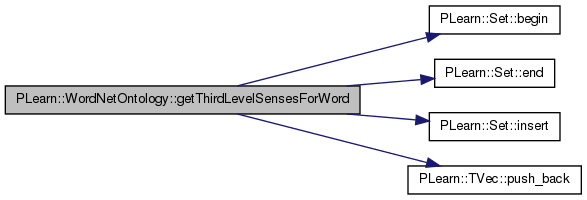
| int PLearn::WordNetOntology::getVocSize | ( | ) | [inline] |
Definition at line 289 of file WordNetOntology.h.
References words.
Referenced by PLearn::GraphicalBiText::build_(), and PLearn::GraphicalBiText::print().
{ return words.size(); }

| string PLearn::WordNetOntology::getWord | ( | int | id | ) | const |
Definition at line 1676 of file WordNetOntology.cc.
References NULL_TAG, and PLWARNING.
Referenced by PLearn::GraphicalBiText::build_(), main(), and PLearn::TextSenseSequenceVMatrix::permute().
{
#ifndef NOWARNING
if (!isWord(id))
{
PLWARNING("asking for a non-word id (%d)", id);
return NULL_TAG;
}
#endif
return words.find(id)->second;
}

Definition at line 1745 of file WordNetOntology.cc.
References PLWARNING.
{
#ifndef NOWARNING
if (!isWord(id))
{
PLWARNING("asking for a non-word id (%d)", id);
return Set();
}
#endif
return word_to_adj_senses[id];
}
Definition at line 1757 of file WordNetOntology.cc.
References PLWARNING.
{
#ifndef NOWARNING
if (!isWord(id))
{
PLWARNING("asking for a non-word id (%d)", id);
return Set();
}
#endif
return word_to_adv_senses[id];
}
Definition at line 1581 of file WordNetOntology.cc.
References PLearn::Set::insert(), PLearn::Set::merge(), and PLWARNING.
{
if (are_ancestors_extracted)
{
if (!isWord(id))
{
#ifndef NOWARNING
PLWARNING("asking for a non-word id (%d)", id);
#endif
}
return word_to_ancestors[id];
} else
{
Set word_ancestors;
if (isWord(id))
{
#ifndef NOWARNING
PLWARNING("using non-pre-computed version");
#endif
for (SetIterator it = word_to_senses[id].begin(); it != word_to_senses[id].end(); ++it)
{
int sense_id = *it;
word_ancestors.insert(sense_id);
Set synset_ancestors = getSynsetAncestors(sense_id, max_level);
word_ancestors.merge(synset_ancestors);
}
} else
{
#ifndef NOWARNING
PLWARNING("asking for a non-word id");
#endif
}
return word_ancestors;
}
}

Definition at line 1705 of file WordNetOntology.cc.
References PLERROR, and PLWARNING.
Referenced by fillTempWordToHighLevelSensesTVecMap().
{
#ifndef NOWARNING
if (!isWord(id))
{
PLWARNING("asking for a non-word id (%d)", id);
return Set();
}
#endif
if (!are_word_high_level_senses_extracted)
PLERROR("word high-level senses have not been extracted");
return word_to_high_level_senses[id];
}

| int PLearn::WordNetOntology::getWordId | ( | string | word | ) | const |
Definition at line 1651 of file WordNetOntology.cc.
References OOV_TAG.
Referenced by PLearn::GraphicalBiText::build_(), PLearn::GraphicalBiText::init(), PLearn::GraphicalBiText::init_WSD(), main(), PLearn::TextSenseSequenceVMatrix::permute(), and PLearn::GraphicalBiText::test_WSD().
{
map<string, int>::const_iterator it = words_id.find(word);
if (it == words_id.end())
{
map<string, int>::const_iterator iit = words_id.find(OOV_TAG);
if (iit == words_id.end())
return -1;
else
return iit->second;
} else
{
return it->second;
}
// #ifndef NOWARNING
// if (words_id.find(word) == words_id.end())
// {
// PLWARNING("asking for a non-word (%s)", word.c_str());
// return -1;
// }
// #endif
// return words_id[word];
}

Definition at line 1721 of file WordNetOntology.cc.
References PLWARNING.
Referenced by PLearn::GraphicalBiText::init().
{
#ifndef NOWARNING
if (!isWord(id))
{
PLWARNING("asking for a non-word id (%d)", id);
return Set();
}
#endif
return word_to_noun_senses[id];
}

| map<int,string> PLearn::WordNetOntology::getWords | ( | ) | [inline] |
| int PLearn::WordNetOntology::getWordSenseIdForSenseKey | ( | string | lemma, |
| string | lexsn, | ||
| string | word | ||
| ) |
Definition at line 887 of file WordNetOntology.cc.
References PLearn::cstr(), PLearn::Node::fnum, PLearn::Node::gloss, PLearn::Node::hereiam, PLearn::Node::ss_id, PLearn::Node::syns, and WNO_ERROR.
Referenced by main().
{
string sense_key = lemma + "%" + lexsn;
char* csense_key = cstr(sense_key);
SynsetPtr ssp = GetSynsetForSense(csense_key);
if (ssp != NULL)
{
vector<string> synset_words = getSynsetWords(ssp);
string gloss = ssp->defn;
int word_id = words_id[word];
long offset = ssp->hereiam;
int fnum = ssp->fnum;
for (SetIterator it = word_to_senses[word_id].begin(); it != word_to_senses[word_id].end(); ++it)
{
Node* node = synsets[*it];
if (node->syns == synset_words && node->gloss == gloss && node->hereiam == offset && node->fnum == fnum)
return node->ss_id;
}
}
return WNO_ERROR;
}


Definition at line 826 of file WordNetOntology.cc.
References ADJ_TYPE, ADV_TYPE, NOUN_TYPE, PLWARNING, VERB_TYPE, and WNO_ERROR.
{
if (!isWord(word))
{
#ifndef NOWARNING
PLWARNING("asking for a non-word (%s)", word.c_str());
#endif
return WNO_ERROR;
}
int word_id = words_id[word];
switch (wn_pos_type)
{
case NOUN_TYPE:
if (wnsn > (int)word_to_noun_wnsn[word_id].size())
{
#ifndef NOWARNING
PLWARNING("invalid noun wnsn (%d)", wnsn);
#endif
return WNO_ERROR;
} else
return word_to_noun_wnsn[word_id][wnsn - 1];
break;
case VERB_TYPE:
if (wnsn > (int)word_to_verb_wnsn[word_id].size())
{
#ifndef NOWARNING
PLWARNING("invalid verb wnsn (%d)", wnsn);
#endif
return WNO_ERROR;
} else
return word_to_verb_wnsn[word_id][wnsn - 1];
break;
case ADJ_TYPE:
if (wnsn > (int)word_to_adj_wnsn[word_id].size())
{
#ifndef NOWARNING
PLWARNING("invalid adj wnsn (%d)", wnsn);
#endif
return WNO_ERROR;
} else
return word_to_adj_wnsn[word_id][wnsn - 1];
break;
case ADV_TYPE:
if (wnsn > (int)word_to_adv_wnsn[word_id].size())
{
#ifndef NOWARNING
PLWARNING("invalid adv wnsn (%d)", wnsn);
#endif
return WNO_ERROR;
} else
return word_to_adv_wnsn[word_id][wnsn - 1];
break;
default:
#ifndef NOWARNING
PLWARNING("undefined type");
#endif
return WNO_ERROR;
}
}
Definition at line 1688 of file WordNetOntology.cc.
References PLWARNING.
Referenced by PLearn::GraphicalBiText::compute_BN_likelihood(), PLearn::GraphicalBiText::compute_nodemap(), PLearn::GraphicalBiText::compute_pTC(), main(), PLearn::GraphicalBiText::print_sensemap(), and PLearn::GraphicalBiText::set_nodemap().
{
#ifndef NOWARNING
if (!isWord(id))
{
PLWARNING("asking for a non-word id (%d)", id);
return Set();
}
#endif
map<int, Set>::const_iterator it = word_to_senses.find(id);
if(it==word_to_senses.end()){
return Set();
}else{
return it->second;
}
}

Definition at line 2778 of file WordNetOntology.cc.
References PLearn::ws().
{
if (!are_word_sense_unique_ids_computed)
computeWordSenseUniqueIds();
pair<int, int> ws(word, sense);
if (word_sense_to_unique_id.find(ws) == word_sense_to_unique_id.end())
return -1;
return word_sense_to_unique_id[ws];
}

| int PLearn::WordNetOntology::getWordSenseUniqueIdSize | ( | ) |
Definition at line 2807 of file WordNetOntology.cc.
{
if (!are_word_sense_unique_ids_computed)
computeWordSenseUniqueIds();
return (int)word_sense_to_unique_id.size();
}
Definition at line 1769 of file WordNetOntology.cc.
References PLWARNING.
Referenced by PLearn::TextSenseSequenceVMatrix::build_().
{
#ifndef NOWARNING
if (!isSense(id))
{
PLWARNING("asking for a non-sense id (%d)", id);
return Set();
}
#endif
return sense_to_words[id];
}

| map<string,int> PLearn::WordNetOntology::getWordsId | ( | ) | [inline] |
Definition at line 1733 of file WordNetOntology.cc.
References PLWARNING.
{
#ifndef NOWARNING
if (!isWord(id))
{
PLWARNING("asking for a non-word id (%d)", id);
return Set();
}
#endif
return word_to_verb_senses[id];
}
Definition at line 352 of file WordNetOntology.cc.
References ADJ_TYPE, ADV_TYPE, PLearn::cstr(), NOUN_TYPE, and VERB_TYPE.
{
//char* cword = const_cast<char*>(word.c_str());
char* cword = cstr(word);
SynsetPtr ssp = NULL;
switch (wn_pos_type)
{
case NOUN_TYPE:
ssp = findtheinfo_ds(cword, NOUN, -HYPERPTR, ALLSENSES);
break;
case VERB_TYPE:
ssp = findtheinfo_ds(cword, VERB, -HYPERPTR, ALLSENSES);
break;
case ADJ_TYPE:
ssp = findtheinfo_ds(cword, ADJ, -HYPERPTR, ALLSENSES);
break;
case ADV_TYPE:
ssp = findtheinfo_ds(cword, ADV, -HYPERPTR, ALLSENSES);
break;
}
bool ssp_is_null = (ssp == NULL);
delete(cword);
free_syns(ssp);
return !ssp_is_null;
}

| void PLearn::WordNetOntology::init | ( | bool | differentiate_unknown_words = true | ) |
Definition at line 106 of file WordNetOntology.cc.
References EOS_SS_ID.
{
if (wninit() != 0) {
// PLERROR("WordNet init error");
}
noun_count = 0;
verb_count = 0;
adj_count = 0;
adv_count = 0;
synset_index = EOS_SS_ID + 1; // first synset id
word_index = 0;
unknown_sense_index = 0;
noun_sense_count = 0;
verb_sense_count = 0;
adj_sense_count = 0;
adv_sense_count = 0;
in_wn_word_count = 0;
out_of_wn_word_count = 0;
are_ancestors_extracted = false;
are_descendants_extracted = false;
are_predominent_pos_extracted = false;
are_word_high_level_senses_extracted = false;
are_word_sense_unique_ids_computed = false;
n_word_high_level_senses = 0;
differentiate_unknown_words = the_differentiate_unknown_words;
}
Definition at line 2078 of file WordNetOntology.cc.
References PLearn::Set::begin(), PLearn::Set::clear(), PLearn::Set::contains(), PLearn::Set::end(), and PLearn::Set::insert().
{
// pour tous les mappings "mot -> ancetres", fait une intersection de "ancetres"
// avec "categories"
for (map<int, Set>::iterator it = word_to_ancestors.begin(); it != word_to_ancestors.end(); ++it)
{
it->second.intersection(categories);
}
// pour tous les mappings "synset -> ancetres" (ou "synset" = "sense" U "category")
// enleve le mapping complet, si "synset" (la cle) n'intersecte pas avec "categories"
Set keys_to_be_removed;
for (map<int, Set>::iterator it = synset_to_ancestors.begin(); it != synset_to_ancestors.end(); ++it)
{
if (!categories.contains(it->first) && !senses.contains(it->first))
keys_to_be_removed.insert(it->first);
}
// purge synset_to_ancestors
for (SetIterator it = keys_to_be_removed.begin(); it != keys_to_be_removed.end(); ++it)
{
synset_to_ancestors.erase(*it);
synsets.erase(*it);
}
// pour tous les mappings "synset -> ancetres" restants (ou "synset" = "sense" U "category")
// fait une intersection de "ancetres" avec "categories"
for (map<int, Set>::iterator it = synset_to_ancestors.begin(); it != synset_to_ancestors.end(); ++it)
{
it->second.intersection(categories);
}
// pour tous les mappings "mot -> senses", fait une intersection de "senses"
// avec "senses"
for (map<int, Set>::iterator it = word_to_senses.begin(); it != word_to_senses.end(); ++it)
{
it->second.intersection(senses);
}
keys_to_be_removed->clear();
for (map<int, Set>::iterator it = sense_to_words.begin(); it != sense_to_words.end(); ++it)
{
if (!senses.contains(it->first))
keys_to_be_removed.insert(it->first);
}
for (SetIterator it = keys_to_be_removed.begin(); it != keys_to_be_removed.end(); ++it)
{
sense_to_words.erase(*it);
}
}
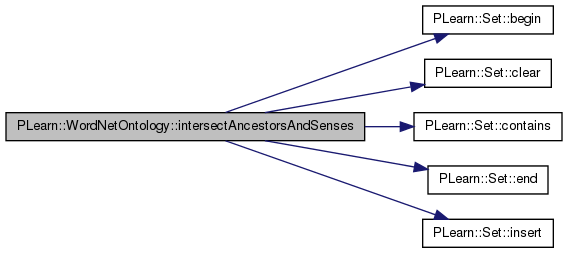
Definition at line 1988 of file WordNetOntology.cc.
{
return isSynset(id);
}
| bool PLearn::WordNetOntology::isInWordNet | ( | string | word, |
| bool | trim_word = true, |
||
| bool | stem_word = true, |
||
| bool | remove_undescores = false |
||
| ) |
Definition at line 303 of file WordNetOntology.cc.
References ADJ_TYPE, ADV_TYPE, NOUN_TYPE, NULL_TAG, PLearn::stemWord(), PLearn::trimWord(), PLearn::underscore_to_space(), and VERB_TYPE.
Referenced by main().
{
if (trim_word)
word = trimWord(word);
if (remove_undescores)
word = underscore_to_space(word);
if (word == NULL_TAG)
{
return false;
} else
{
bool found_noun = hasSenseInWordNet(word, NOUN_TYPE);
bool found_verb = hasSenseInWordNet(word, VERB_TYPE);
bool found_adj = hasSenseInWordNet(word, ADJ_TYPE);
bool found_adv = hasSenseInWordNet(word, ADV_TYPE);
bool found_stemmed_noun = false;
bool found_stemmed_verb = false;
bool found_stemmed_adj = false;
bool found_stemmed_adv = false;
if (stem_word)
{
string stemmed_word = stemWord(word, NOUN);
if (stemmed_word != word)
found_stemmed_noun = hasSenseInWordNet(stemmed_word, NOUN_TYPE);
stemmed_word = stemWord(word, VERB);
if (stemmed_word != word)
found_stemmed_verb = hasSenseInWordNet(stemmed_word, VERB_TYPE);
stemmed_word = stemWord(word, ADJ);
if (stemmed_word != word)
found_stemmed_adj = hasSenseInWordNet(stemmed_word, ADJ_TYPE);
stemmed_word = stemWord(word, ADV);
if (stemmed_word != word)
found_stemmed_adv = hasSenseInWordNet(stemmed_word, ADV_TYPE);
}
if (found_noun || found_verb || found_adj || found_adv ||
found_stemmed_noun || found_stemmed_verb || found_stemmed_adj || found_stemmed_adv)
{
return true;
} else
{
return false;
}
}
}


Definition at line 1618 of file WordNetOntology.cc.
References PLWARNING.
{
#ifndef NOWARNING
if (!isWord(word_id))
{
PLWARNING("asking for a non-word id (%d)", word_id);
return false;
}
#endif
return word_is_in_wn.find(word_id)->second;
}
Definition at line 1993 of file WordNetOntology.cc.
Referenced by PLearn::GraphicalBiText::compute_pTC().
{
return (isCategory(id) && !isSense(id));
}

Definition at line 1983 of file WordNetOntology.cc.
Referenced by PLearn::GraphicalBiText::compute_pTC().

Definition at line 1978 of file WordNetOntology.cc.
Referenced by PLearn::GraphicalBiText::init(), and PLearn::GraphicalBiText::init_WSD().
{
return (sense_to_words.find(id) != sense_to_words.end());
}

Definition at line 1998 of file WordNetOntology.cc.
Referenced by PLearn::GraphicalBiText::compute_node_level(), PLearn::GraphicalBiText::compute_nodemap(), PLearn::GraphicalBiText::compute_pMC(), and PLearn::GraphicalBiText::set_nodemap().

Definition at line 2145 of file WordNetOntology.cc.
{
return synsets[id]->is_unknown;
}
Definition at line 2616 of file WordNetOntology.cc.
References ADJ_SS_ID, ADV_SS_ID, BOS_SS_ID, EOS_SS_ID, NOUN_SS_ID, NUMERIC_SS_ID, OOV_SS_ID, PROPER_NOUN_SS_ID, PUNCTUATION_SS_ID, ROOT_SS_ID, STOP_SS_ID, SUPER_UNKNOWN_SS_ID, UNDEFINED_SS_ID, and VERB_SS_ID.
{
return (ss_id == ROOT_SS_ID || ss_id == SUPER_UNKNOWN_SS_ID ||
ss_id == NOUN_SS_ID || ss_id == VERB_SS_ID ||
ss_id == ADJ_SS_ID || ss_id == ADV_SS_ID ||
ss_id == OOV_SS_ID || ss_id == PROPER_NOUN_SS_ID ||
ss_id == NUMERIC_SS_ID || ss_id == PUNCTUATION_SS_ID ||
ss_id == STOP_SS_ID || ss_id == UNDEFINED_SS_ID ||
ss_id == BOS_SS_ID || ss_id == EOS_SS_ID);
}
| bool PLearn::WordNetOntology::isWord | ( | string | word | ) |
Definition at line 1973 of file WordNetOntology.cc.
Definition at line 1968 of file WordNetOntology.cc.
Referenced by PLearn::GraphicalBiText::compute_likelihood(), PLearn::GraphicalBiText::init(), PLearn::GraphicalBiText::init_WSD(), PLearn::GraphicalBiText::sensetag_valid_bitext(), PLearn::GraphicalBiText::senseTagBitext(), PLearn::GraphicalBiText::test_WSD(), and PLearn::GraphicalBiText::update_WSD_model().

| bool PLearn::WordNetOntology::isWordUnknown | ( | string | word | ) |
Definition at line 2129 of file WordNetOntology.cc.
{
return isWordUnknown(words_id[word]);
}
Definition at line 2134 of file WordNetOntology.cc.
{
bool is_unknown = true;
for (SetIterator it = word_to_senses[id].begin(); it != word_to_senses[id].end(); ++it)
{
if (!synsets[*it]->is_unknown)
is_unknown = false;
}
return is_unknown;
}
| void PLearn::WordNetOntology::linkUpperCategories | ( | ) |
Definition at line 974 of file WordNetOntology.cc.
References ADJ_SS_ID, ADJ_TYPE, ADV_SS_ID, ADV_TYPE, PLearn::Set::contains(), PLearn::Set::insert(), NOUN_SS_ID, NOUN_TYPE, PLearn::Node::parents, ROOT_SS_ID, PLearn::Set::size(), PLearn::Node::types, VERB_SS_ID, and VERB_TYPE.
{
for (map<int, Node*>::iterator it = synsets.begin(); it != synsets.end(); ++it)
{
int ss_id = it->first;
Node* node = it->second;
if (node->parents.size() == 0 && ss_id != ROOT_SS_ID)
{
bool link_directly_to_root = true;
if (node->types.contains(NOUN_TYPE))
{
node->parents.insert(NOUN_SS_ID);
synsets[NOUN_SS_ID]->children.insert(ss_id);
link_directly_to_root = false;
}
if (node->types.contains(VERB_TYPE))
{
node->parents.insert(VERB_SS_ID);
synsets[VERB_SS_ID]->children.insert(ss_id);
link_directly_to_root = false;
}
if (node->types.contains(ADJ_TYPE))
{
node->parents.insert(ADJ_SS_ID);
synsets[ADJ_SS_ID]->children.insert(ss_id);
link_directly_to_root = false;
}
if (node->types.contains(ADV_TYPE))
{
node->parents.insert(ADV_SS_ID);
synsets[ADV_SS_ID]->children.insert(ss_id);
link_directly_to_root = false;
}
if (link_directly_to_root)
{
node->parents.insert(ROOT_SS_ID);
synsets[ROOT_SS_ID]->children.insert(ss_id);
}
}
}
}

| void PLearn::WordNetOntology::load | ( | string | voc_file, |
| string | synset_file, | ||
| string | ontology_file | ||
| ) |
Definition at line 1267 of file WordNetOntology.cc.
References ADJ_TYPE, ADV_TYPE, PLearn::ShellProgressBar::done(), PLearn::ShellProgressBar::draw(), PLearn::Node::fnum, PLearn::ShellProgressBar::getAsciiFileLineCount(), PLearn::Node::gloss, PLearn::Node::hereiam, i, PLearn::Set::insert(), NOUN_TYPE, PLERROR, PLWARNING, PLearn::split(), PLearn::Node::ss_id, PLearn::startsWith(), PLearn::Node::syns, PLearn::tobool(), PLearn::toint(), PLearn::tolong(), PLearn::Node::types, PLearn::ShellProgressBar::update(), and VERB_TYPE.
{
ifstream if_voc(voc_file.c_str());
if (!if_voc) PLERROR("can't open %s", voc_file.c_str());
ifstream if_synsets(synset_file.c_str());
if (!if_synsets) PLERROR("can't open %s", synset_file.c_str());
ifstream if_ontology(ontology_file.c_str());
if (!if_ontology) PLERROR("can't open %s", ontology_file.c_str());
string line;
int word_count = 0;
while (!if_voc.eof()) // voc
{
getline(if_voc, line, '\n');
if (line == "") continue;
if (line[0] == '#' && line[1] == '#') continue;
words_id[line] = word_count;
word_to_senses[word_count] = Set();
words[word_count++] = line;
}
if_voc.close();
word_index = word_count;
int line_no = 0;
int ss_id = -1;
while (!if_synsets.eof()) // synsets
{
++line_no;
getline(if_synsets, line, '\n');
if (line == "") continue;
if (line[0] == '#') continue;
vector<string> tokens = split(line, "*");
if (tokens.size() != 3 && tokens.size() != 4)
PLERROR("the synset file has not the expected format, line %d = '%s'", line_no, line.c_str());
if(tokens.size() == 3 && line_no == 1)
PLWARNING("The synset file doesn't contain enough information for correct representation of the synsets!");
ss_id = toint(tokens[0]);
vector<string> type_tokens = split(tokens[1], "|");
vector<string> ss_tokens = split(tokens[2], "|");
vector<string> offset_tokens;
if(tokens.size() == 4) offset_tokens = split(tokens[3],"|");
Node* node = new Node(ss_id);
for (unsigned int i = 0; i < type_tokens.size(); i++)
node->types.insert(toint(type_tokens[i]));
node->gloss = ss_tokens[0];
//node->syns.reserve(ss_tokens.size() - 1);
for (unsigned int i = 1; i < ss_tokens.size(); i++)
{
if (i == 1) // extract unknown_sense_index
if (startsWith(ss_tokens[i], "UNKNOWN_SENSE_"))
unknown_sense_index = toint(ss_tokens[i].substr(14, ss_tokens[i].size())) + 1;
node->syns.push_back(ss_tokens[i]);
}
if(tokens.size() == 4)
{
node->fnum = toint(offset_tokens[0]);
node->hereiam = tolong(offset_tokens[1]);
}
synsets[node->ss_id] = node;
}
synset_index = ss_id + 1;
if_synsets.close();
int n_lines = ShellProgressBar::getAsciiFileLineCount(ontology_file);
ShellProgressBar progress(0, n_lines - 1, "loading ontology", 50);
progress.draw();
int counter = 0;
while (!if_ontology.eof()) // ontology
{
getline(if_ontology, line, '\n');
progress.update(counter++);
if (line == "") continue;
if (line[0] == '#') continue;
vector<string> tokens = split(line);
if (tokens.size() != 3)
{
PLERROR("the ontology file has not the expected format");
}
int id = toint(tokens[1]);
int child_id;
if (tokens[0] == "w")
{
bool is_in_wn = tobool(tokens[2]);
word_is_in_wn[id] = is_in_wn;
if (is_in_wn)
in_wn_word_count++;
else
out_of_wn_word_count++;
} else if (tokens[0] == "s")
{
child_id = toint(tokens[2]);
word_to_senses[child_id].insert(id);
sense_to_words[id].insert(child_id);
for (SetIterator tit = synsets[id]->types.begin(); tit != synsets[id]->types.end(); ++tit)
{
int type = *tit;
switch (type)
{
case NOUN_TYPE:
word_to_noun_senses[child_id].insert(id);
break;
case VERB_TYPE:
word_to_verb_senses[child_id].insert(id);
break;
case ADJ_TYPE:
word_to_adj_senses[child_id].insert(id);
break;
case ADV_TYPE:
word_to_adv_senses[child_id].insert(id);
break;
}
}
} else if (tokens[0] == "c")
{
child_id = toint(tokens[2]);
synsets[child_id]->parents.insert(id);
synsets[id]->children.insert(child_id);
}
}
if_ontology.close();
progress.done();
if_voc.close();
if_synsets.close();
if_ontology.close();
}

| void PLearn::WordNetOntology::load | ( | string | voc_file, |
| string | synset_file, | ||
| string | ontology_file, | ||
| string | sense_key_file | ||
| ) |
Definition at line 1392 of file WordNetOntology.cc.
References PLearn::load(), PLERROR, PLearn::split(), PLearn::toint(), and PLearn::ws().
{
load(voc_file, synset_file, ontology_file);
ifstream if_sense_key(sense_key_file.c_str());
if (!if_sense_key) PLERROR("can't open %s", sense_key_file.c_str());
string line;
while (!if_sense_key.eof()) // voc
{
getline(if_sense_key, line, '\n');
if (line == "") continue;
if (line[0] == '#' && line[1] == '#') continue;
vector<string> tokens = split(line, " ");
if(tokens.size() != 3)
PLERROR("sense_key_file %s not compatible", sense_key_file.c_str());
pair<int, string> ss(toint(tokens[1]), tokens[0]);
sense_key_to_ss_id[ss] = toint(tokens[2]);
pair<int, int> ws(toint(tokens[1]), toint(tokens[2]));
ws_id_to_sense_key[ws] = tokens[0];
}
if_sense_key.close();
}
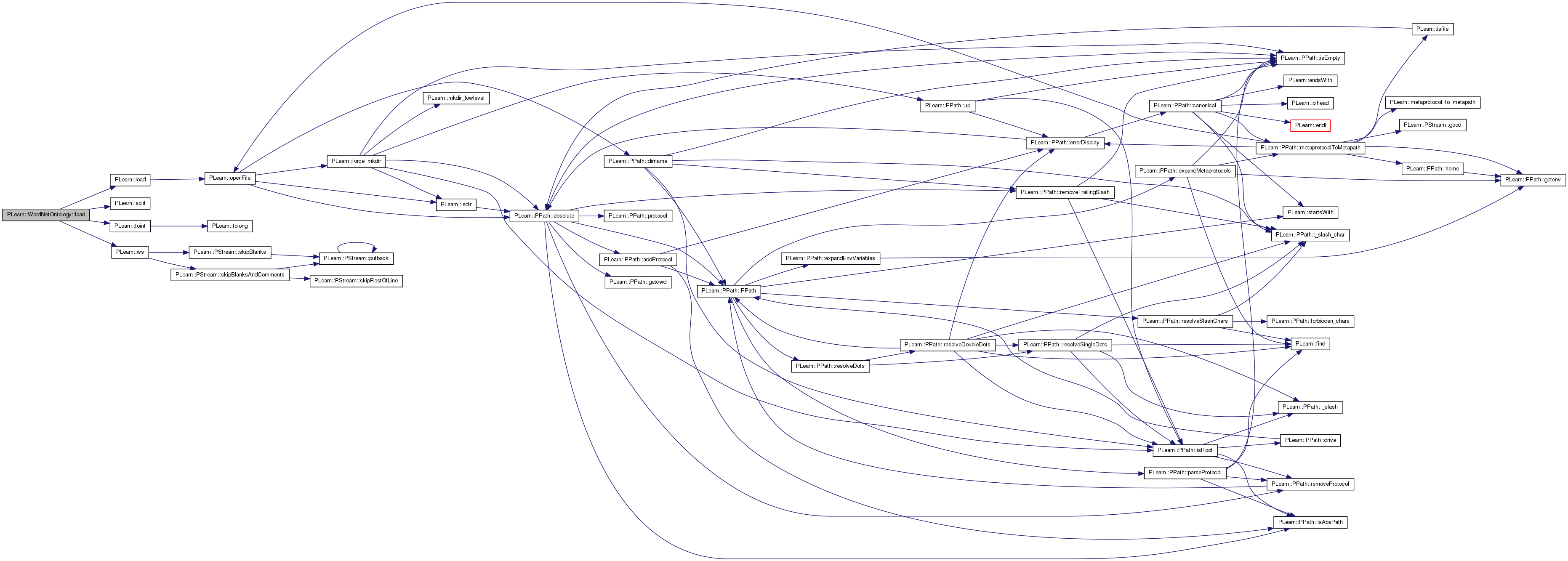
| void PLearn::WordNetOntology::loadPredominentSyntacticClasses | ( | string | file | ) |
Definition at line 2601 of file WordNetOntology.cc.
References PLearn::pgetline(), and PLearn::toint().
{
ifstream in_pos(file.c_str());
int line_counter = 0;
while (!in_pos.eof())
{
string line = pgetline(in_pos);
if (line == "") continue;
int pos = toint(line);
word_to_predominent_pos[line_counter++] = pos;
}
in_pos.close();
are_predominent_pos_extracted = true;
}

| void PLearn::WordNetOntology::lookForSpecialTags | ( | ) |
Definition at line 805 of file WordNetOntology.cc.
References NUMERIC_SS_ID, OOV_SS_ID, PLWARNING, PROPER_NOUN_SS_ID, PUNCTUATION_SS_ID, and STOP_SS_ID.
{
if (!isSense(OOV_SS_ID))
PLWARNING("no <oov> tag found");
if (!isSense(PROPER_NOUN_SS_ID))
PLWARNING("no <proper_noun> tag found");
if (!isSense(NUMERIC_SS_ID))
PLWARNING("no <numeric> tag found");
if (!isSense(PUNCTUATION_SS_ID))
PLWARNING("no <punctuation> tag found");
if (!isSense(STOP_SS_ID))
PLWARNING("no <stop> tag found");
}
Definition at line 2003 of file WordNetOntology.cc.
References PLearn::Set::begin(), PLearn::Set::contains(), PLearn::Set::end(), PLearn::Set::insert(), and PLearn::Set::size().
Referenced by areOverlappingSynsets().
{
Set words1 = sense_to_words[ss_id1];
Set words2 = sense_to_words[ss_id2];
Set overlap;
for (SetIterator it1=words1.begin();it1!=words1.end();++it1)
if (words2.contains(*it1))
overlap.insert(*it1);
//for (set<int>::iterator it=overlap.begin();it!=overlap.end();++it)
// cout << words[*it] << endl;
return overlap.size();
}
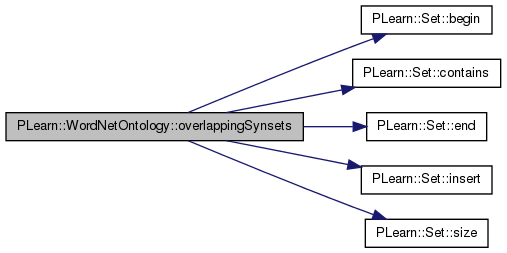

| void PLearn::WordNetOntology::print | ( | bool | print_ontology = true | ) |
Definition at line 1070 of file WordNetOntology.cc.
References PLearn::endl().
Referenced by main().
{
for (map<int, Set>::iterator it = word_to_senses.begin(); it != word_to_senses.end(); ++it)
{
cout << words[it->first] << endl;
for (SetIterator iit = it->second.begin(); iit != it->second.end(); ++iit)
{
printSynset(*iit, 1);
if (print_ontology)
{
printOntology(synsets[*iit], 2);
}
}
}
}


| void PLearn::WordNetOntology::printDescendants | ( | ) |
Definition at line 1951 of file WordNetOntology.cc.
{
/*
if (!are_descendants_extracted)
{
extractDescendants();
}
for (map<int, Set>::iterator it = synset_to_descendants.begin(); it != synset_to_descendants.end(); ++it)
{
cout << it->first << " -> ";
for (SetIterator iit = it->second.begin(); iit != it->second.end(); ++iit)
cout << *iit << " ";
cout << endl;
}
*/
}
Definition at line 2061 of file WordNetOntology.cc.
References PLWARNING.
{
if (isSynset(id))
{
printSynset(id, level);
for (SetIterator it = synsets[id]->children.begin(); it != synsets[id]->children.end(); ++it)
{
printInvertedSynsetOntology(*it, level + 1);
}
} else
{
#ifndef NOWARNING
PLWARNING("asking for a non-synset id (%d)", id);
#endif
}
}
| void PLearn::WordNetOntology::printNodes | ( | ) |
Definition at line 1416 of file WordNetOntology.cc.
References PLearn::Set::begin(), PLearn::Node::children, PLearn::Set::end(), PLearn::endl(), PLearn::Node::parents, and PLearn::Node::ss_id.
{
for (map<int, Node*>::iterator it = synsets.begin(); it != synsets.end(); ++it)
{
Node* node = it->second;
cout << "Node id = " << node->ss_id << " | parents = ";
for (SetIterator pit = node->parents.begin(); pit != node->parents.end(); ++pit)
{
cout << *pit << " ";
}
cout << " | children = ";
for (SetIterator cit = node->children.begin(); cit != node->children.end(); ++cit)
{
cout << *cit << " ";
}
cout << endl;
}
}

Definition at line 1086 of file WordNetOntology.cc.
References PLearn::Set::begin(), PLearn::Set::end(), and PLearn::Node::parents.
{
for (SetIterator it = node->parents.begin(); it != node->parents.end(); ++it)
{
printSynset(*it, level);
printOntology(synsets[*it], level + 1);
}
}

| void PLearn::WordNetOntology::printStats | ( | ) |
Definition at line 1151 of file WordNetOntology.cc.
References PLearn::endl().
Referenced by main().
{
/*
cout << getSenseSize() << " senses (" << noun_sense_count << " nouns, " << verb_sense_count << " verbs, "
<< adj_sense_count << " adjectives, " << adv_sense_count << " adverbs) for " << getVocSize() << " words" << endl;
cout << out_of_wn_word_count << " out-of-wordnet words" << endl;
cout << in_wn_word_count << " in-wordnet words" << endl;
cout << noun_count << " nouns" << endl;
cout << verb_count << " verbs" << endl;
cout << adj_count << " adjectives" << endl;
cout << adv_count << " adverbs" << endl;
cout << (double)getSenseSize() / (double)getVocSize() << " senses per word on average" << endl;
int all_classes = noun_count + verb_count + adj_count + adv_count;
cout << (double)all_classes / (double)in_wn_count << " classes per word on average" << endl;
*/
cout << getVocSize() << " words in vocabulary" << endl;
cout << in_wn_word_count << " in WN words" << endl;
cout << out_of_wn_word_count << " out of WN words" << endl;
cout << getSenseSize() << " senses (" << (real)getSenseSize() / (real)getVocSize() << " senses per word on average)" << endl;
cout << getSynsetSize() << " categories (ontology : sense + category, possible overlap)" << endl;
if (are_word_high_level_senses_extracted)
{
cout << n_word_high_level_senses << " high-level senses (" << (real)n_word_high_level_senses / (real)getVocSize() << " high-level senses per word on average)" << endl;
}
}


Definition at line 1134 of file WordNetOntology.cc.
References PLearn::endl(), and i.
{
for (int i = 0; i < indent_level; i++) sout << " "; // indent
sout << "=> ";
for (vector<string>::iterator it = synsets[ss_id]->syns.begin(); it != synsets[ss_id]->syns.end(); ++it)
{
sout << *it << ", ";
}
sout << " (" << ss_id << ")" << endl;
for (int i = 0; i < indent_level; i++) cout << " "; // indent
sout << "gloss = " << synsets[ss_id]->gloss << endl;
}

Definition at line 1095 of file WordNetOntology.cc.
References PLearn::endl(), and i.
Referenced by PLearn::GraphicalBiText::compute_pMC(), and PLearn::GraphicalBiText::init().
{
for (int i = 0; i < indent_level; i++) cout << " "; // indent
cout << "=> ";
for (vector<string>::iterator it = synsets[ss_id]->syns.begin(); it != synsets[ss_id]->syns.end(); ++it)
{
cout << *it << ", ";
}
cout << " (" << ss_id << ")" << endl;
for (int i = 0; i < indent_level; i++) cout << " "; // indent
cout << "fnum: " << synsets[ss_id]->fnum << "synset offset: " << synsets[ss_id]->hereiam << " gloss = " << synsets[ss_id]->gloss << endl;
//cout << "syns = " << synsets[ss_id]->syns << endl;
// cout << " {";
// for (SetIterator it = synsets[ss_id]->types.begin(); it != synsets[ss_id]->types.end(); ++it)
// {
// int type = *it;
// switch (type)
// {
// case NOUN_TYPE:
// cout << "noun ";
// break;
// case VERB_TYPE:
// cout << "verb ";
// break;
// case ADJ_TYPE:
// cout << "adjective ";
// break;
// case ADV_TYPE:
// cout << "adverb ";
// break;
// case UNDEFINED_TYPE:
// cout << "undefined ";
// break;
// }
// }
// cout << "}" << endl;
}


| void PLearn::WordNetOntology::printSynsetAncestors | ( | ) |
Definition at line 1799 of file WordNetOntology.cc.
References PLearn::endl(), PLearn::extractAncestors(), and WORD_COVERAGE_THRESHOLD.
{
if (!are_ancestors_extracted)
{
extractAncestors(WORD_COVERAGE_THRESHOLD, true, true);
}
for (map<int, Set>::iterator it = synset_to_ancestors.begin(); it != synset_to_ancestors.end(); ++it)
{
cout << it->first << " -> ";
for (SetIterator iit = it->second.begin(); iit != it->second.end(); ++iit)
cout << *iit << " ";
cout << endl;
}
}

| void PLearn::WordNetOntology::printWordAncestors | ( | ) |
Definition at line 1814 of file WordNetOntology.cc.
References PLearn::Set::begin(), PLearn::Set::end(), PLearn::endl(), PLearn::extractAncestors(), and WORD_COVERAGE_THRESHOLD.
{
if (!are_ancestors_extracted)
{
extractAncestors(WORD_COVERAGE_THRESHOLD, true, true);
}
for (map<int, Set>::iterator it = word_to_senses.begin(); it != word_to_senses.end(); ++it)
{
int id = it->first;
cout << id << " -> ";
Set ancestors = getWordAncestors(id);
for (SetIterator iit = ancestors.begin(); iit != ancestors.end(); ++iit)
{
cout << *iit << " ";
}
cout << endl;
}
}

| void PLearn::WordNetOntology::printWordOntology | ( | int | id | ) |
Definition at line 2045 of file WordNetOntology.cc.
References PLearn::endl().
{
cout << words[id] << endl;
for (SetIterator sit = word_to_senses[id].begin(); sit != word_to_senses[id].end(); ++sit)
{
int sense_id = *sit;
printSynset(sense_id, 1);
printOntology(synsets[sense_id], 2);
}
}

| void PLearn::WordNetOntology::printWordOntology | ( | string | word | ) |
Definition at line 2056 of file WordNetOntology.cc.
{
printWordOntology(words_id[word]);
}
| void PLearn::WordNetOntology::processUnknownWord | ( | int | word_id | ) |
Definition at line 909 of file WordNetOntology.cc.
References EOS_OFFSET, PLearn::Node::gloss, PLearn::Node::hereiam, PLearn::Set::insert(), PLearn::Node::parents, PLearn::Node::ss_id, SUPER_UNKNOWN_SS_ID, PLearn::Node::syns, PLearn::tostring(), PLearn::Node::types, and UNDEFINED_TYPE.
{
if (differentiate_unknown_words)
{
// create an UNKNOWN synset for a particular word
Node* unk_node = new Node(synset_index++);
int unknown_sense_id = unknown_sense_index++;
unk_node->syns.push_back("UNKNOWN_SENSE_" + tostring(unknown_sense_id));
unk_node->gloss = "(unknown sense " + tostring(unknown_sense_id) + ")";
unk_node->types.insert(UNDEFINED_TYPE);
unk_node->hereiam = EOS_OFFSET - unknown_sense_id - 1;
synsets[unk_node->ss_id] = unk_node;
// link UNKNOWN <-> SUPER-UNKNOWN
unk_node->parents.insert(SUPER_UNKNOWN_SS_ID);
synsets[SUPER_UNKNOWN_SS_ID]->children.insert(unk_node->ss_id);
word_to_senses[word_id].insert(unk_node->ss_id);
sense_to_words[unk_node->ss_id].insert(word_id);
} else // all the unknown words are linked to SUPER-UNKNOWN
{ // (acting in this context as a sense)
word_to_senses[word_id].insert(SUPER_UNKNOWN_SS_ID);
sense_to_words[SUPER_UNKNOWN_SS_ID].insert(word_id);
}
}

| void PLearn::WordNetOntology::propagatePOSTypes | ( | Node * | node | ) |
Definition at line 946 of file WordNetOntology.cc.
References PLearn::Set::begin(), PLearn::Set::end(), PLearn::Set::insert(), PLearn::Node::parents, PLWARNING, PLearn::Set::size(), PLearn::Node::types, and PLearn::Node::visited.
{
node->visited = true;
for (SetIterator it = node->parents.begin(); it != node->parents.end(); ++it)
{
Node* parent_node = synsets[*it];
for (SetIterator iit = node->types.begin(); iit != node->types.end(); ++iit)
{
parent_node->types.insert(*iit);
}
if (parent_node->types.size() > 1)
{
#ifndef NOWARNING
PLWARNING("a synset has more than 1 type");
#endif
}
if (!parent_node->visited)
propagatePOSTypes(parent_node);
}
}
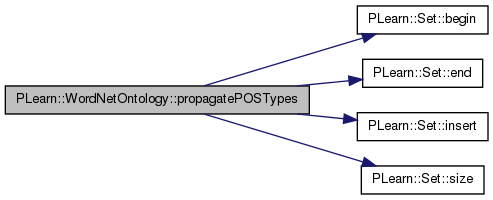
| void PLearn::WordNetOntology::propagatePOSTypes | ( | ) |
Definition at line 936 of file WordNetOntology.cc.
{
for (map<int, Set>::iterator it = sense_to_words.begin(); it != sense_to_words.end(); ++it)
{
Node* node = synsets[it->first];
propagatePOSTypes(node);
}
unvisitAll();
}
| void PLearn::WordNetOntology::reducePolysemy | ( | int | level | ) |
Definition at line 2220 of file WordNetOntology.cc.
References PLearn::ShellProgressBar::init().
{
ShellProgressBar progress(0, words.size() - 1, "reducing polysemy", 50);
progress.init();
progress.draw();
int count = 0;
for (map<int, string>::iterator it = words.begin(); it != words.end(); ++it)
{
int word_id = it->first;
//reduceWordPolysemy(word_id, level);
reduceWordPolysemy_preserveSenseOverlapping(word_id, level);
progress.update(count++);
}
progress.done();
removeNonReachableSynsets();
}

Definition at line 2240 of file WordNetOntology.cc.
References PLearn::Set::begin(), PLearn::Set::end(), PLearn::Set::insert(), and PLearn::Set::size().
{
Set senses = word_to_senses[word_id];
Set senses_to_be_removed;
if (senses.size() > 1)
{
//SetsValuesSet svs;
set<set<int> > ss;
for (SetIterator it = senses.begin(); it != senses.end(); ++it)
{
int sense_id = *it;
set<int> categories_at_level;
getCategoriesAtLevel(sense_id, 0, level, categories_at_level);
// cout << "sense_id = " << sense_id << ", categories_at_level[" << level << "] for word '" << words[word_id] << "' : ";
// for (set<int>::iterator sit = categories_at_level.begin(); sit != categories_at_level.end(); ++sit)
// cout << *sit << " ";
if (categories_at_level.size() != 0)
{
// if a list of categories, for a given sense, is already extracted
// (through a different sense) mark the sense for deletion
//bool already_there = !svs.insert(categories_at_level, sense_id);
bool already_there = (ss.find(categories_at_level) != ss.end());
if (already_there)
{
//cout << "*" << endl;
senses_to_be_removed.insert(sense_id);
sense_to_words[sense_id].remove(word_id);
// if a sense doesn't point to any word anymore, erase it from the sense table
if (sense_to_words[sense_id].isEmpty())
sense_to_words.erase(sense_id);
} else
{
ss.insert(categories_at_level);
//cout << endl;
}
} else
{
//cout << endl;
}
}
// erase the marked senses
for (SetIterator it = senses_to_be_removed.begin(); it != senses_to_be_removed.end(); ++it)
{
int sense_id = *it;
word_to_senses[word_id].remove(sense_id);
word_to_noun_senses[word_id].remove(sense_id);
word_to_verb_senses[word_id].remove(sense_id);
word_to_adj_senses[word_id].remove(sense_id);
word_to_adv_senses[word_id].remove(sense_id);
}
}
}
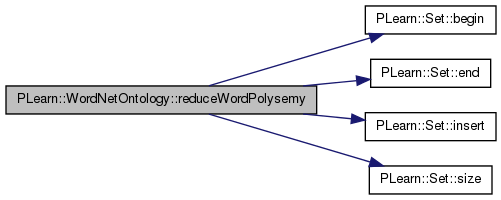
| void PLearn::WordNetOntology::reduceWordPolysemy_preserveSenseOverlapping | ( | int | word_id, |
| int | level | ||
| ) |
Definition at line 2295 of file WordNetOntology.cc.
References PLearn::Set::begin(), PLearn::Set::end(), PLearn::endl(), PLearn::Set::insert(), PLearn::Set::isEmpty(), and PLearn::Set::size().
{
Set senses = word_to_senses[word_id];
Set senses_to_be_removed;
map<set<int>, Set> categories_to_senses;
if (senses.size() > 1)
{
for (SetIterator it = senses.begin(); it != senses.end(); ++it)
{
int sense_id = *it;
set<int> categories_at_level;
getCategoriesAtLevel(sense_id, 0, level, categories_at_level);
if (categories_at_level.size() != 0)
categories_to_senses[categories_at_level].insert(sense_id);
}
for (map<set<int>, Set>::iterator it = categories_to_senses.begin(); it != categories_to_senses.end(); ++it)
{
Set sense_cluster = it->second;
if (sense_cluster.size() > 1)
{
int sense_cluster_size = sense_cluster.size();
int n_sense_removed = 0;
for (SetIterator sit = sense_cluster.begin(); sit != sense_cluster.end(); ++sit)
{
int sense_id = *sit;
if (sense_to_words[sense_id].size() < 2 && n_sense_removed < (sense_cluster_size - 1))
{
senses_to_be_removed.insert(sense_id);
sense_to_words[sense_id].remove(word_id);
// if a sense doesn't point to any word anymore, erase it from the sense table
if (sense_to_words[sense_id].isEmpty())
sense_to_words.erase(sense_id);
n_sense_removed++;
}
}
}
}
if (!senses_to_be_removed.isEmpty())
{
cout << words[word_id] << endl;
// cout << "senses = " << senses;
// cout << ", senses_to_be_removed = " << senses_to_be_removed << endl;
}
// erase the marked senses
for (SetIterator it = senses_to_be_removed.begin(); it != senses_to_be_removed.end(); ++it)
{
int sense_id = *it;
printSynset(sense_id, 1);
word_to_senses[word_id].remove(sense_id);
word_to_noun_senses[word_id].remove(sense_id);
word_to_verb_senses[word_id].remove(sense_id);
word_to_adj_senses[word_id].remove(sense_id);
word_to_adv_senses[word_id].remove(sense_id);
}
}
}

| void PLearn::WordNetOntology::reduceWordPolysemy_preserveSenseOverlapping2 | ( | int | word_id, |
| int | level | ||
| ) |
Definition at line 2357 of file WordNetOntology.cc.
{
/*
Set senses = word_to_senses[word_id];
Set senses_to_be_removed;
map<int, Set> sense_to_categories_under_level(senses.size());
if (senses.size() > 1)
{
for (SetIterator it = senses.begin(); it != senses.end(); ++it)
{
int sense_id = *it;
Set categories_under_level;
getCategoriesUnderLevel(sense_id, 0, level, categories_under_level);
sense_to_categories_under_level[sense_id] = categories_under_level;
}
if (!senses_to_be_removed.isEmpty())
{
//cout << words[word_id] << endl;
//cout << "senses = " << senses;
//cout << ", senses_to_be_removed = " << senses_to_be_removed << endl;
}
// erase the marked senses
for (SetIterator it = senses_to_be_removed.begin(); it != senses_to_be_removed.end(); ++it)
{
int sense_id = *it;
printSynset(sense_id, 1);
word_to_senses[word_id].remove(sense_id);
word_to_noun_senses[word_id].remove(sense_id);
word_to_verb_senses[word_id].remove(sense_id);
word_to_adj_senses[word_id].remove(sense_id);
word_to_adv_senses[word_id].remove(sense_id);
}
}
*/
}
| void PLearn::WordNetOntology::removeNonReachableSynsets | ( | ) |
Definition at line 2398 of file WordNetOntology.cc.
References PLearn::Set::begin(), PLearn::Node::children, PLearn::Set::end(), PLearn::Set::insert(), PLearn::Set::remove(), and PLearn::Node::visited.
Referenced by PLearn::GraphicalBiText::build_().
{
// visit the whole graph, beginning with words, and going upward, and marking the nodes
for (map<int, Set>::iterator wit = word_to_senses.begin(); wit != word_to_senses.end(); ++wit)
{
Set senses = wit->second;
for (SetIterator sit = senses.begin(); sit != senses.end(); ++sit)
{
int sense_id = *sit;
visitUpward(synsets[sense_id]);
}
}
// mark synsets that need to be removed
Set synsets_to_be_removed;
for (map<int, Node*>::iterator sit = synsets.begin(); sit != synsets.end(); ++sit)
{
int ss_id = sit->first;
Node* node = sit->second;
if (!node->visited)
{
synsets_to_be_removed.insert(ss_id);
} else
{
// for a synset that does not need to be removed, check if there are child pointers
// to a removed one (mark them for deletion if so)
Set children_to_be_removed;
for (SetIterator cit = node->children.begin(); cit != node->children.end(); ++cit)
{
int child_id = *cit;
if (!synsets[child_id]->visited)
children_to_be_removed.insert(child_id);
}
// remove the marked child pointers
for (SetIterator rit = children_to_be_removed.begin(); rit != children_to_be_removed.end(); ++rit)
node->children.remove(*rit);
}
}
// remove the marked synsets
for (SetIterator rit = synsets_to_be_removed.begin(); rit != synsets_to_be_removed.end(); ++rit)
{
int ss_id = *rit;
delete(synsets[ss_id]);
synsets.erase(ss_id);
}
unvisitAll();
}
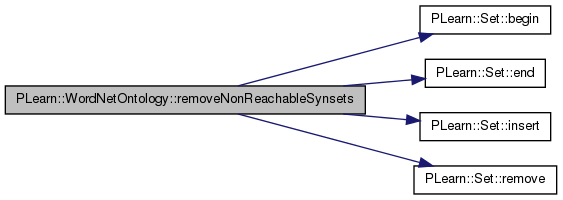

| void PLearn::WordNetOntology::removeWord | ( | int | id | ) |
Definition at line 2447 of file WordNetOntology.cc.
Referenced by PLearn::GraphicalBiText::build_().
{
string word_string = words[id];
words.erase(id);
word_to_senses.erase(id);
word_to_noun_senses.erase(id);
word_to_verb_senses.erase(id);
word_to_adj_senses.erase(id);
word_to_adv_senses.erase(id);
words_id.erase(word_string);
word_to_noun_wnsn.erase(id);
word_to_verb_wnsn.erase(id);
word_to_adj_wnsn.erase(id);
word_to_adv_wnsn.erase(id);
word_to_predominent_pos.erase(id);
// word_is_in_wn[id]=0 Should I do that ?
word_to_high_level_senses.erase(id);
}

| void PLearn::WordNetOntology::save | ( | string | voc_file | ) |
Definition at line 1229 of file WordNetOntology.cc.
References PLearn::endl().
{
ofstream of_voc(voc_file.c_str());
for (map<int, string>::iterator it = words.begin(); it != words.end(); ++it)
{
of_voc << it->second << endl;
}
of_voc.close();
}

| void PLearn::WordNetOntology::save | ( | string | synset_file, |
| string | ontology_file, | ||
| string | sense_key_file | ||
| ) |
Definition at line 1254 of file WordNetOntology.cc.
References PLearn::endl(), and PLearn::save().
{
save(synset_file, ontology_file);
ofstream of_voc(sense_key_file.c_str());
for (map<pair<int, int>, string>::iterator it = ws_id_to_sense_key.begin(); it != ws_id_to_sense_key.end(); ++it)
{
of_voc << it->second << " " << (it->first).first << " " << (it->first).second << endl;
}
of_voc.close();
}
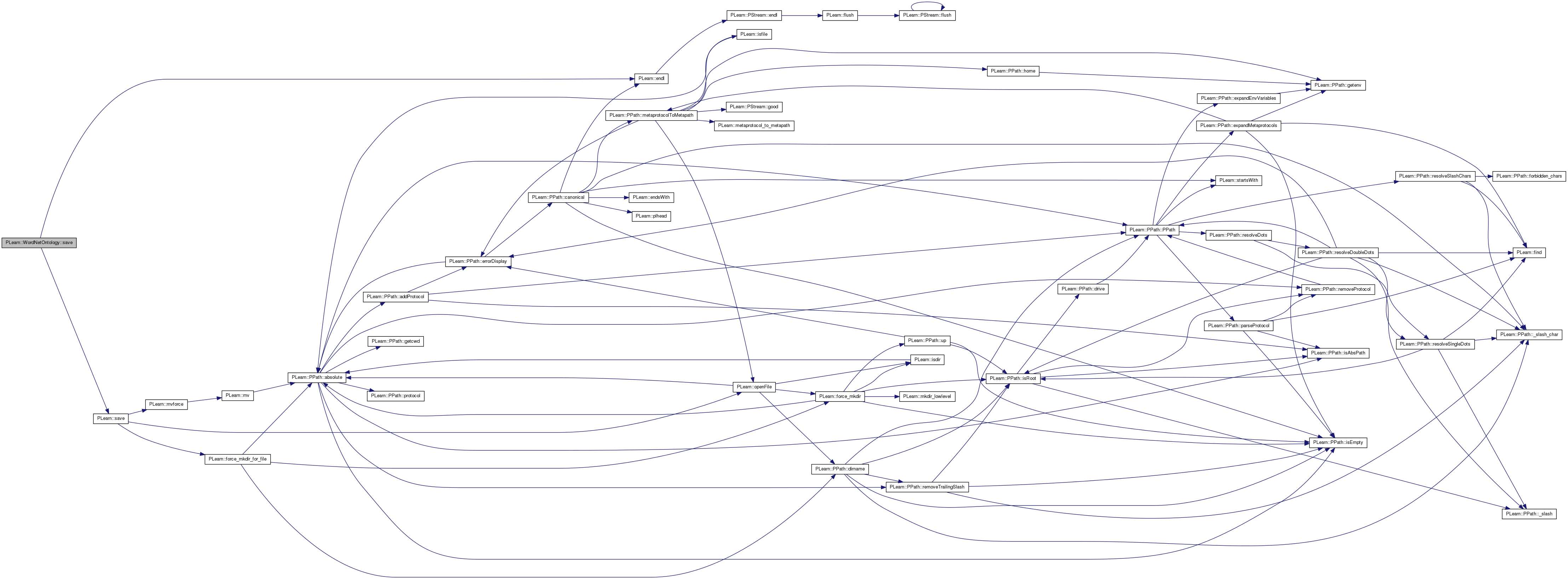
| void PLearn::WordNetOntology::save | ( | string | synset_file, |
| string | ontology_file | ||
| ) |
Definition at line 1177 of file WordNetOntology.cc.
References PLearn::Set::begin(), PLearn::Node::children, PLearn::Set::end(), PLearn::endl(), PLearn::Node::fnum, PLearn::Node::gloss, PLearn::Node::hereiam, PLearn::Node::syns, and PLearn::Node::types.
Referenced by main().
{
// synset
ofstream of_synsets(synset_file.c_str());
for (map<int, Node*>::iterator it = synsets.begin(); it != synsets.end(); ++it)
{
int ss_id = it->first;
Node* node = it->second;
of_synsets << ss_id << "*|";
for (SetIterator it = node->types.begin(); it != node->types.end(); ++it)
{
of_synsets << *it << "|";
}
of_synsets << "*|";
of_synsets << node->gloss << "|";
for (vector<string>::iterator iit = node->syns.begin(); iit != node->syns.end(); ++iit)
{
of_synsets << *iit << "|";
}
of_synsets << "*|";
of_synsets << node->fnum << "|";
of_synsets << node->hereiam << "|";
of_synsets << endl;
}
of_synsets.close();
// ontology
ofstream of_ontology(ontology_file.c_str());
for (map<int, Set>::iterator wit = word_to_senses.begin(); wit != word_to_senses.end(); ++wit)
{
int word_id = wit->first;
of_ontology << "w " << word_id << " " << word_is_in_wn[word_id] << endl;
}
for (map<int, Node*>::iterator it = synsets.begin(); it != synsets.end(); ++it)
{
int id = it->first;
Node* node = it->second;
for(SetIterator iit = node->children.begin(); iit != node->children.end(); ++iit)
{
int child_id = *iit;
of_ontology << "c " << id << " " << child_id << endl;
}
if (sense_to_words.find(id) != sense_to_words.end())
{
for (SetIterator iit = sense_to_words[id].begin(); iit != sense_to_words[id].end(); ++iit)
of_ontology << "s " << id << " " << (*iit) << endl;
}
}
of_ontology.close();
}


| void PLearn::WordNetOntology::savePredominentSyntacticClasses | ( | string | file | ) |
Definition at line 2589 of file WordNetOntology.cc.
References PLearn::endl().
{
ofstream out_pos(file.c_str());
for (map<int, Set>::iterator it = word_to_senses.begin(); it != word_to_senses.end(); ++it)
{
int word_id = it->first;
out_pos << getPredominentSyntacticClassForWord(word_id) << endl;
}
out_pos.close();
}

| void PLearn::WordNetOntology::saveVocInWordnet | ( | string | voc_file | ) |
Definition at line 1240 of file WordNetOntology.cc.
References PLearn::endl().
{
ofstream of_voc(voc_file.c_str());
for (map<int, string>::iterator it = words.begin(); it != words.end(); ++it)
{
if (word_is_in_wn[it->first] == false)continue;
of_voc << it->second << endl;
}
of_voc.close();
}

| void PLearn::WordNetOntology::unvisitAll | ( | ) |
Definition at line 967 of file WordNetOntology.cc.
| void PLearn::WordNetOntology::unvisitDownward | ( | Node * | node | ) |
Definition at line 2479 of file WordNetOntology.cc.
References PLearn::Set::begin(), PLearn::Node::children, PLearn::Set::end(), and PLearn::Node::visited.
{
node->visited = false;
for (SetIterator s_it = node->children.begin(); s_it != node->children.end(); ++s_it) {
Node *child = synsets[*s_it];
if (child->visited)
unvisitDownward(child);
}
}

| void PLearn::WordNetOntology::visitUpward | ( | Node * | node | ) |
Definition at line 2467 of file WordNetOntology.cc.
References PLearn::Set::begin(), PLearn::Set::end(), PLearn::Node::parents, and PLearn::Node::visited.
{
node->visited = true;
for (SetIterator pit = node->parents.begin(); pit != node->parents.end(); ++pit)
{
int parent_id = *pit;
if (!synsets[parent_id]->visited)
visitUpward(synsets[parent_id]);
}
}

int PLearn::WordNetOntology::adj_count [protected] |
Definition at line 200 of file WordNetOntology.h.
int PLearn::WordNetOntology::adj_sense_count [protected] |
Definition at line 205 of file WordNetOntology.h.
int PLearn::WordNetOntology::adv_count [protected] |
Definition at line 201 of file WordNetOntology.h.
int PLearn::WordNetOntology::adv_sense_count [protected] |
Definition at line 206 of file WordNetOntology.h.
bool PLearn::WordNetOntology::are_ancestors_extracted [protected] |
Definition at line 212 of file WordNetOntology.h.
Definition at line 213 of file WordNetOntology.h.
Definition at line 214 of file WordNetOntology.h.
Definition at line 215 of file WordNetOntology.h.
Definition at line 216 of file WordNetOntology.h.
Definition at line 225 of file WordNetOntology.h.
int PLearn::WordNetOntology::in_wn_word_count [protected] |
Definition at line 208 of file WordNetOntology.h.
int PLearn::WordNetOntology::n_word_high_level_senses [protected] |
Definition at line 218 of file WordNetOntology.h.
int PLearn::WordNetOntology::noun_count [protected] |
Definition at line 198 of file WordNetOntology.h.
int PLearn::WordNetOntology::noun_sense_count [protected] |
Definition at line 203 of file WordNetOntology.h.
int PLearn::WordNetOntology::out_of_wn_word_count [protected] |
Definition at line 209 of file WordNetOntology.h.
map< pair<int, string>,int> PLearn::WordNetOntology::sense_key_to_ss_id [protected] |
Definition at line 190 of file WordNetOntology.h.
map<int, Set> PLearn::WordNetOntology::sense_to_words [protected] |
Definition at line 173 of file WordNetOntology.h.
Referenced by getSenseSize().
int PLearn::WordNetOntology::synset_index [protected] |
Definition at line 194 of file WordNetOntology.h.
map<int, Set> PLearn::WordNetOntology::synset_to_ancestors [protected] |
Definition at line 174 of file WordNetOntology.h.
map<int, Set> PLearn::WordNetOntology::synset_to_sense_descendants [protected] |
Definition at line 176 of file WordNetOntology.h.
map<int, Set> PLearn::WordNetOntology::synset_to_word_descendants [protected] |
Definition at line 177 of file WordNetOntology.h.
map<int, Node*> PLearn::WordNetOntology::synsets [protected] |
Definition at line 178 of file WordNetOntology.h.
Referenced by getRootSynset(), getSecondLevelSensesForWord(), getSynsetSize(), and getThirdLevelSensesForWord().
Definition at line 389 of file WordNetOntology.h.
Referenced by fillTempWordToSensesTVecMap(), PLearn::TextSenseSequenceVMatrix::permute(), and PLearn::GraphicalBiText::test_WSD().
Definition at line 390 of file WordNetOntology.h.
Referenced by fillTempWordToSensesTVecMap(), PLearn::TextSenseSequenceVMatrix::permute(), and PLearn::GraphicalBiText::test_WSD().
Definition at line 391 of file WordNetOntology.h.
Referenced by fillTempWordToHighLevelSensesTVecMap(), and getHighLevelSensesForWord().
Definition at line 387 of file WordNetOntology.h.
Referenced by fillTempWordToSensesTVecMap(), PLearn::TextSenseSequenceVMatrix::permute(), and PLearn::GraphicalBiText::test_WSD().
Definition at line 386 of file WordNetOntology.h.
Referenced by fillTempWordToSensesTVecMap(), and getSensesForWord().
Definition at line 388 of file WordNetOntology.h.
Referenced by fillTempWordToSensesTVecMap(), PLearn::TextSenseSequenceVMatrix::permute(), and PLearn::GraphicalBiText::test_WSD().
int PLearn::WordNetOntology::unknown_sense_index [protected] |
Definition at line 195 of file WordNetOntology.h.
int PLearn::WordNetOntology::verb_count [protected] |
Definition at line 199 of file WordNetOntology.h.
int PLearn::WordNetOntology::verb_sense_count [protected] |
Definition at line 204 of file WordNetOntology.h.
int PLearn::WordNetOntology::word_index [protected] |
Definition at line 193 of file WordNetOntology.h.
map<int, bool> PLearn::WordNetOntology::word_is_in_wn [protected] |
Definition at line 186 of file WordNetOntology.h.
map<pair<int, int>, int> PLearn::WordNetOntology::word_sense_to_unique_id [protected] |
Definition at line 188 of file WordNetOntology.h.
map<int, Set> PLearn::WordNetOntology::word_to_adj_senses [protected] |
Definition at line 171 of file WordNetOntology.h.
Referenced by fillTempWordToSensesTVecMap().
map<int, vector<int> > PLearn::WordNetOntology::word_to_adj_wnsn [protected] |
Definition at line 183 of file WordNetOntology.h.
map<int, Set> PLearn::WordNetOntology::word_to_adv_senses [protected] |
Definition at line 172 of file WordNetOntology.h.
Referenced by fillTempWordToSensesTVecMap().
map<int, vector<int> > PLearn::WordNetOntology::word_to_adv_wnsn [protected] |
Definition at line 184 of file WordNetOntology.h.
map<int, Set> PLearn::WordNetOntology::word_to_ancestors [protected] |
Definition at line 175 of file WordNetOntology.h.
map<int, Set> PLearn::WordNetOntology::word_to_high_level_senses [protected] |
Definition at line 187 of file WordNetOntology.h.
map<int, Set> PLearn::WordNetOntology::word_to_noun_senses [protected] |
Definition at line 169 of file WordNetOntology.h.
Referenced by fillTempWordToSensesTVecMap().
map<int, vector<int> > PLearn::WordNetOntology::word_to_noun_wnsn [protected] |
Definition at line 181 of file WordNetOntology.h.
map<int, int> PLearn::WordNetOntology::word_to_predominent_pos [protected] |
Definition at line 185 of file WordNetOntology.h.
map<int, Set> PLearn::WordNetOntology::word_to_senses [protected] |
Definition at line 168 of file WordNetOntology.h.
Referenced by fillTempWordToSensesTVecMap(), getSecondLevelSensesForWord(), and getThirdLevelSensesForWord().
map<int, Set> PLearn::WordNetOntology::word_to_under_target_level_high_level_senses [protected] |
Definition at line 189 of file WordNetOntology.h.
map<int, Set> PLearn::WordNetOntology::word_to_verb_senses [protected] |
Definition at line 170 of file WordNetOntology.h.
Referenced by fillTempWordToSensesTVecMap().
map<int, vector<int> > PLearn::WordNetOntology::word_to_verb_wnsn [protected] |
Definition at line 182 of file WordNetOntology.h.
map<int, string> PLearn::WordNetOntology::words [protected] |
Definition at line 179 of file WordNetOntology.h.
Referenced by containsWordId(), fillTempWordToHighLevelSensesTVecMap(), getVocSize(), and getWords().
map<string, int> PLearn::WordNetOntology::words_id [protected] |
Definition at line 180 of file WordNetOntology.h.
Referenced by containsWord(), and getWordsId().
map<pair<int,int>, string> PLearn::WordNetOntology::ws_id_to_sense_key [protected] |
Definition at line 191 of file WordNetOntology.h.
 1.7.4
1.7.4